Chapter-14 Biomolecules
It is the harmonious and synchronous progress of chemical reactions in body which leads to life.
A living system grows, sustains and reproduces itself. The most amazing thing about a living system is that it is composed of non-living atoms and molecules. The pursuit of knowledge of what goes on chemically within a living system falls in the domain of biochemistry. Living systems are made up of various complex biomolecules like carbohydrates, proteins, nucleic acids, lipids, etc. Proteins and carbohydrates are essential constituents of our food. These biomolecules interact with each other and constitute the molecular logic of life processes. In addition, some simple molecules like vitamins and mineral salts also play an important role in the functions of organisms. Structures and functions of some of these biomolecules are discussed in this Unit.
14.1 Carbohydrates
Carbohydrates are primarily produced by plants and form a very large group of naturally occurring organic compounds. Some common examples of carbohydrates are cane sugar, glucose, starch, etc. Most of them have a general formula, $\mathrm{C_\mathrm{x}}\left(\mathrm{H_2} \mathrm{O}\right)_{\mathrm{y}}$, and were considered as hydrates of carbon from where the name carbohydrate was derived. For example, the molecular formula of glucose $\left(\mathrm{C_6} \mathrm{H_12} \mathrm{O_6}\right)$ fits into this general formula, $\mathrm{C_6}\left(\mathrm{H_2} \mathrm{O}\right)_6$. But all the compounds which fit into this formula may not be classified as carbohydrates. For example acetic acid $\left(\mathrm{CH_3} \mathrm{COOH}\right)$ fits into this general formula, $\mathrm{C_2}\left(\mathrm{H_2} \mathrm{O}\right)_2$ but is not a carbohydrate. Similarly, rhamnose, $\mathrm{C_6} \mathrm{H_12} \mathrm{O_5}$ is a carbohydrate but does not fit in this definition. A large number of their reactions have shown that they contain specific functional groups. Chemically, the carbohydrates may be defined as optically active polyhydroxy aldehydes or ketones or the compounds which produce such units on hydrolysis. Some of the carbohydrates, which are sweet in taste, are also called sugars. The most common sugar, used in our homes is named as sucrose whereas the sugar present in milk is known as lactose. Carbohydrates are also called saccharides (Greek: sakcharon means sugar).
14.1.1 Classification of Carbohydrates
Carbohydrates are classified on the basis of their behaviour on hydrolysis. They have been broadly divided into following three groups.
(i) Monosaccharides: A carbohydrate that cannot be hydrolysed further to give simpler unit of polyhydroxy aldehyde or ketone is called a monosaccharide. About 20 monosaccharides are known to occur in nature. Some common examples are glucose, fructose, ribose, etc.
(ii) Oligosaccharides: Carbohydrates that yield two to ten monosaccharide units, on hydrolysis, are called oligosaccharides. They are further classified as disaccharides, trisaccharides, tetrasaccharides, etc., depending upon the number of monosaccharides, they provide on hydrolysis. Amongst these the most common are disaccharides. The two monosaccharide units obtained on hydrolysis of a disaccharide may be same or different. For example, one molecule of sucrose on hydrolysis gives one molecule of glucose and one molecule of fructose whereas maltose gives two molecules of only glucose.
(iii) Polysaccharides: Carbohydrates which yield a large number of monosaccharide units on hydrolysis are called polysaccharides. Some common examples are starch, cellulose, glycogen, gums, etc. Polysaccharides are not sweet in taste, hence they are also called non-sugars.
The carbohydrates may also be classified as either reducing or nonreducing sugars. All those carbohydrates which reduce Fehling’s solution and Tollens’ reagent are referred to as reducing sugars. All monosaccharides whether aldose or ketose are reducing sugars.
14.1.2 Monosaccharides
Monosaccharides are further classified on the basis of number of carbon atoms and the functional group present in them. If a monosaccharide contains an aldehyde group, it is known as an aldose and if it contains a keto group, it is known as a ketose. Number of carbon atoms constituting the monosaccharide is also introduced in the name as is evident from the examples given in Table 14.1
Table 14.1: Different Types of Monosaccharides
| Carbon atoms | General term | Aldehyde | Ketone |
|---|---|---|---|
| 3 | Triose | Aldotriose | Ketotriose |
| 4 | Tetrose | Aldotetrose | Ketotetrose |
| 5 | Pentose | Aldopentose | Ketopentose |
| 6 | Hexose | Aldohexose | Ketohexose |
| 7 | Heptose | Aldoheptose | Ketoheptose |
14.1.2.1 Glucose
Glucose occurs freely in nature as well as in the combined form. It is present in sweet fruits and honey. Ripe grapes also contain glucose in large amounts. It is prepared as follows:
Preparation of Glucose
1. From sucrose (Cane sugar): If sucrose is boiled with dilute $\mathrm{HCl}$ or $\mathrm{H_2} \mathrm{SO_4}$ in alcoholic solution, glucose and fructose are obtained in equal amounts.
$$ \begin{aligned} & \underset{\text { Sucrose} }{\mathrm{C} _{12} \mathrm{H} _{22} \mathrm{O} _{11}} +\mathrm{H} _2 \mathrm{O} \xrightarrow{\mathrm{H}^{+}} \underset{ \text { Glucose } }{\mathrm{C} _6 \mathrm{H} _{12} \mathrm{O} _6}+ \underset{ \text { Fructose } }{\mathrm{C} _6 \mathrm{H} _{12} \mathrm{O} _6} \end{aligned} $$
2. From starch: Commercially glucose is obtained by hydrolysis of starch by boiling it with dilute $\mathrm{H_2} \mathrm{SO_4}$ at $393 \mathrm{~K}$ under pressure.
$$ \underset{\text { Starch or cellulose }}{\left(\mathrm{C_6} \mathrm{H_10} \mathrm{O_5}\right)_{\mathrm{n}}}+\mathrm{nH_2} \mathrm{O} \xrightarrow[\text { 393K; 2-3} \mathrm{ atm} ] {[\mathrm{H}^{+}]} \underset{ \text{Glucose} }{\mathrm{nC_6} \mathrm{H_12} \mathrm{O_6} } $$
Structure of Glucose
Glucose is an aldohexose and is also known as dextrose. It is the monomer of many of the larger carbohydrates, namely starch, cellulose. It is probably the most abundant organic compound on earth. It was assigned the structure given below on the basis of the following evidences:
1. Its molecular formula was found to be $\mathrm{C_6} \mathrm{H_12} \mathrm{O_6}$.

2. On prolonged heating with $\mathrm{HI}$, it forms n-hexane, suggesting that all the six carbon atoms are linked in a straight chain.

3. Glucose reacts with hydroxylamine to form an oxime and adds a molecule of hydrogen cyanide to give cyanohydrin. These reactions confirm the presence of a carbonyl group ( $>\mathrm{C}=\mathrm{O}$) in glucose.

4. Glucose gets oxidised to six carbon carboxylic acid (gluconic acid) on reaction with a mild oxidising agent like bromine water. This indicates that the carbonyl group is present as an aldehydic group.

5. Acetylation of glucose with acetic anhydride gives glucose pentaacetate which confirms the presence of five –OH groups. Since it exists as a stable compound, five –OH groups should be attached to different carbon atoms.
6. On oxidation with nitric acid, glucose as well as gluconic acid both yield a dicarboxylic acid, saccharic acid. This indicates the presence of a primary alcoholic $(-\mathrm{OH})$ group in glucose.

The exact spatial arrangement of different —OH groups was given by Fischer after studying many other properties. Its configuration is correctly represented as I. So gluconic acid is represented as II and saccharic acid as III.
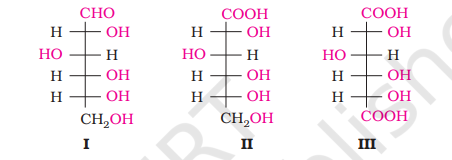
Glucose is correctly named as $\mathrm{D}(+)$-glucose. ’ $\mathrm{D}$ ’ before the name of glucose represents the configuration whereas ’ $(+)$ ’ represents dextrorotatory nature of the molecule. It should be remembered that ’ $D$ ’ and ’ $L$ ’ have no relation with the optical activity of the compound. They are also not related to letter ’d’ and ’l’ (see Unit 6). The meaning of $\mathrm{D}-$ and $\mathrm{L}-$ notations is as follows.
The letters ’ $D$ ’ or ’ $L$ ’ before the name of any compound indicate the relative configuration of a particular stereoisomer of a compound with respect to configuration of some other compound, configuration of which is known. In the case of carbohydrates, this refers to their relation with a particular isomer of glyceraldehyde. Glyceraldehyde contains one asymmetric carbon atom and exists in two enantiomeric forms as shown below.

$(+)$ Isomer of glyceraldehyde has ’ $D$ ’ configuration. It means that when its structural formula is written on paper following specific conventions which you will study in higher classes, the-OH group lies on right hand side in the structure. All those compounds which can be chemically correlated to $\mathrm{D}(+)$ isomer of glyceraldehyde are said to have Dconfiguration whereas those which can be correlated to ’ $\mathrm{L}$ ’ $(-)$ isomer of glyceraldehyde are said to have $\mathrm{L}-$ configuration. In L (-) isomer $-\mathrm{OH}$ group is on left hand side as you can see in the structure. For assigning the configuration of monosaccharides, it is the lowest asymmetric carbon atom (as shown below) which is compared. As in (+) glucose, $-\mathrm{OH}$ on the lowest asymmetric carbon is on the right side which is comparable to (+) glyceraldehyde, so (+) glucose is assigned D-configuration. Other asymmetric carbon atoms of glucose are not considered for this comparison. Also, the structure of glucose and glyceraldehyde is written in a way that most oxidised carbon (in this case - $\mathrm{CHO}$ )is at the top.
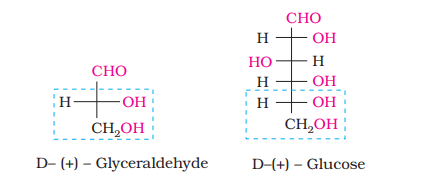
Cyclic Structure of Glucose
The structure (I) of glucose explained most of its properties but the following reactions and facts could not be explained by this structure.
1. Despite having the aldehyde group, glucose does not give Schiff’s test and it does not form the hydrogensulphite addition product with $\mathrm{NaHSO_3}$.
2. The pentaacetate of glucose does not react with hydroxylamine indicating the absence of free - $\mathrm{CHO}$ group.
3. Glucose is found to exist in two different crystalline forms which are named as $\alpha$ and $\beta$. The $\alpha$-form of glucose (m.p. $419 \mathrm{~K}$ ) is obtained by crystallisation from concentrated solution of glucose at $303 \mathrm{~K}$ while the $\beta$-form (m.p. $423 \mathrm{~K}$ ) is obtained by crystallisation from hot and saturated aqueous solution at $371 \mathrm{~K}$.
This behaviour could not be explained by the open chain structure (I) for glucose. It was proposed that one of the - $\mathrm{OH}$ groups may add to the - $\mathrm{CHO}$ group and form a cyclic hemiacetal structure. It was found that glucose forms a six-membered ring in which - $\mathrm{OH}$ at $\mathrm{C}-5$ is involved in ring formation. This explains the absence of $-\mathrm{CHO}$ group and also existence of glucose in two forms as shown below. These two cyclic forms exist in equilibrium with open chain structure.

The two cyclic hemiacetal forms of glucose differ only in the configuration of the hydroxyl group at $\mathrm{C} 1$, called anomeric carbon (the aldehyde carbon before cyclisation). Such isomers, i.e., $\alpha$-form and $\beta$-form, are called anomers. The six membered cyclic structure of glucose is called pyranose structure ( $\alpha-$ or $\beta-$ ), in analogy with pyran. Pyran is a cyclic organic compound with one oxygen atom and five carbon atoms in the ring. The cyclic structure of glucose is more correctly represented by Haworth structure as given below.

14.1.2.2 Fructose
Fructose is an important ketohexose. It is obtained along with glucose by the hydrolysis of disaccharide, sucrose. It is a natural monosaccharide found in fruits, honey and vegetables. In its pure form it is used as a sweetner. It is also an important ketohexose.
Structure of Fructose
Fructose also has the molecular formula $\mathrm{C_6} \mathrm{H_12} \mathrm{O_6}$ and on the basis of its reactions it was found to contain a ketonic functional group at carbon number 2 and six carbons in straight chain as in the case of glucose. It belongs to $\mathrm{D}$-series and is a laevorotatory compound. It is appropriately written as D-(-)-fructose. Its open chain structure is as shown.
It also exists in two cyclic forms which are obtained $D-(-)-$ Fructose by the addition of $-\mathrm{OH}$ at $\mathrm{C} 5$ to the $(-\mathrm{C}=\mathrm{O})$ group. The ring, thus formed is a five membered ring and is named as furanose with analogy to the compound furan. Furan is a five membered cyclic compound with one oxygen and four carbon atoms.

The cyclic structures of two anomers of fructose are represented by Haworth structures as given.
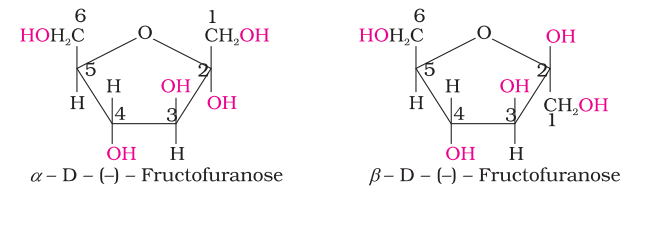
14.1.3 Disaccharides
You have already read that disaccharides on hydrolysis with dilute acids or enzymes yield two molecules of either the same or different monosaccharides. The two monosaccharides are joined together by an oxide linkage formed by the loss of a water molecule. Such a linkage between two monosaccharide units through oxygen atom is called glycosidic linkage.
In disaccharides, if the reducing groups of monosaccharides i.e., aldehydic or ketonic groups are bonded, these are non-reducing sugars, e.g., sucrose. On the other hand, sugars in which these functional groups are free, are called reducing sugars, for example, maltose and lactose.
(i) Sucrose: One of the common disaccharides is sucrose which on hydrolysis gives equimolar mixture of $\mathrm{D}-(+)$-glucose and $\mathrm{D}-(-)$ fructose.
$$\underset{\text { Sucrose }}{\mathrm{C} _{12} \mathrm{H} _{22}} \mathrm{O} _{11}+\mathrm{H} _2 \mathrm{O} \longrightarrow \underset{\text { D-(+)-Glucose }}{\mathrm{C} _6 \mathrm{H} _{12} \mathrm{O} _6}+\underset{\text { D-(-)-Fructose }}{\mathrm{C}_6 \mathrm{H} _{12} \mathrm{O} _6}$$
These two monosaccharides are held together by a glycosidic linkage between $\mathrm{C} 1$ of $\alpha$-D-glucose and $\mathrm{C} 2$ of $\beta$-D-fructose. Since the reducing groups of glucose and fructose are involved in glycosidic bond formation, sucrose is a non reducing sugar.
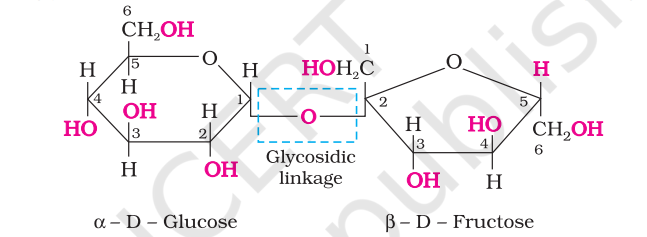
Sucrose is dextrorotatory but after hydrolysis gives dextrorotatory glucose and laevorotatory fructose. Since the laevorotation of fructose $\left(-92.4^{\circ}\right)$ is more than dextrorotation of glucose $\left(+52.5^{\circ}\right)$, the mixture is laevorotatory. Thus, hydrolysis of sucrose brings about a change in the sign of rotation, from dextro $(+)$ to laevo $(-)$ and the product is named as invert sugar.
(ii) Maltose: Another disaccharide, maltose is composed of two $\alpha$-D-glucose units in which $\mathrm{C} 1$ of one glucose (I) is linked to C4 of another glucose unit (II). The free aldehyde group can be produced at $\mathrm{C} 1$ of second glucose in solution and it shows reducing properties so it is a reducing sugar.
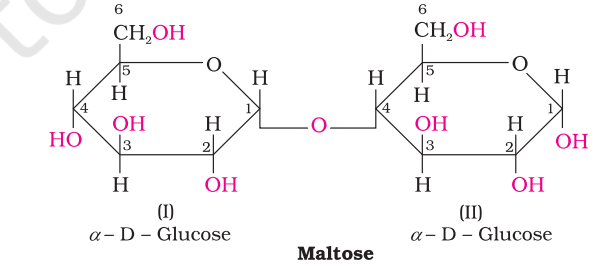
(iii) Lactose: It is more commonly known as milk sugar since this disaccharide is found in milk. It is composed of $\beta$-D-galactose and $\beta$-D-glucose. The linkage is between $\mathrm{C} 1$ of galactose and $\mathrm{C} 4$ of glucose. Free aldehyde group may be produced at C-1 of glucose unit, hence it is also a reducing sugar.
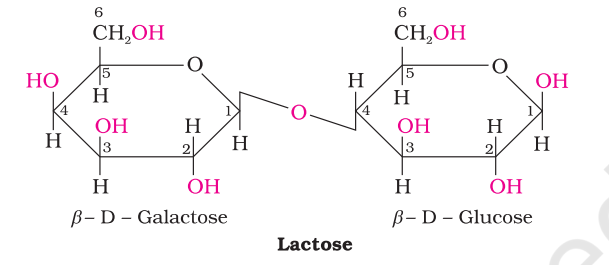
14.1.4 Polysaccharides
Polysaccharides contain a large number of monosaccharide units joined together by glycosidic linkages. These are the most commonly encountered carbohydrates in nature. They mainly act as the food storage or structural materials.
(i) Starch: Starch is the main storage polysaccharide of plants. It is the most important dietary source for human beings. High content of starch is found in cereals, roots, tubers and some vegetables. It is a polymer of $\alpha$-glucose and consists of two componentsAmylose and Amylopectin. Amylose is water soluble component which constitutes about $15-20 %$ of starch. Chemically amylose is a long unbranched chain with 200-1000 $\alpha$-D-(+)-glucose units held together by $\mathrm{C} 1-\mathrm{C} 4$ glycosidic linkage.
Amylopectin is insoluble in water and constitutes about 80$85 %$ of starch. It is a branched chain polymer of $\alpha$-D-glucose units in which chain is formed by $\mathrm{C} 1-\mathrm{C} 4$ glycosidic linkage whereas branching occurs by C1-C6 glycosidic linkage.
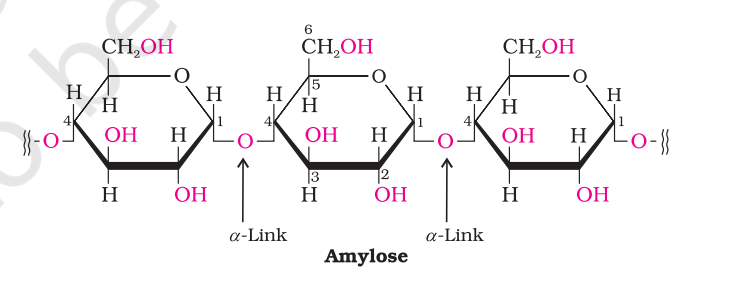
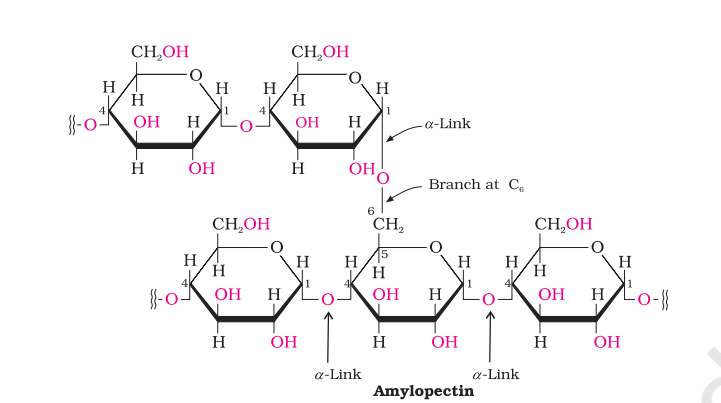
(ii) Cellulose: Cellulose occurs exclusively in plants and it is the most abundant organic substance in plant kingdom. It is a predominant constituent of cell wall of plant cells. Cellulose is a straight chain polysaccharide composed only of $\beta$-D-glucose units which are joined by glycosidic linkage between $\mathrm{C} 1$ of one glucose unit and $\mathrm{C} 4$ of the next glucose unit.
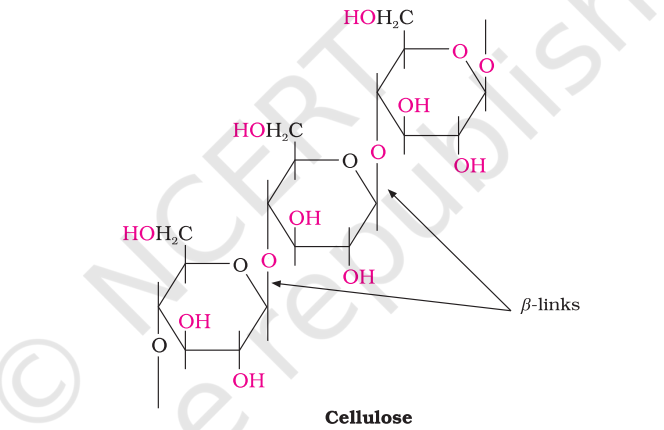
(iii) Glycogen: The carbohydrates are stored in animal body as glycogen. It is also known as animal starch because its structure is similar to amylopectin and is rather more highly branched. It is present in liver, muscles and brain. When the body needs glucose, enzymes break the glycogen down to glucose. Glycogen is also found in yeast and fungi.
14.1.5 Importance of Carbohydrates
Carbohydrates are essential for life in both plants and animals. They form a major portion of our food. Honey has been used for a long time as an instant source of energy by ‘Vaids’ in ayurvedic system of medicine. Carbohydrates are used as storage molecules as starch in plants and glycogen in animals. Cell wall of bacteria and plants is made up of cellulose. We build furniture, etc. from cellulose in the form of wood and clothe ourselves with cellulose in the form of cotton fibre. They provide raw materials for many important industries like textiles, paper, lacquers and breweries.
Two aldopentoses viz. D-ribose and 2-deoxy-D-ribose (Section 14.5.1, Class XII) are present in nucleic acids. Carbohydrates are found in biosystem in combination with many proteins and lipids.
Intext Questions
14.1 Glucose or sucrose are soluble in water but cyclohexane or benzene (simple six membered ring compounds) are insoluble in water. Explain.
Show Answer
Answer
A glucose molecule contains five $-\mathrm{OH}$ groups while a sucrose molecule contains eight $-\mathrm{OH}$ groups. Thus, glucose and sucrose undergo extensive $\mathrm{H}$-bonding with water.
Hence, these are soluble in water.
But cyclohexane and benzene do not contain - $\mathrm{OH}$ groups. Hence, they cannot undergo $\mathrm{H}$-bonding with water and as a result, are insoluble in water.
14.2 What are the expected products of hydrolysis of lactose?
Show Answer
Answer
Lactose is composed of $\beta-D$ galactose and $\beta-D$ glucose. Thus, on hydrolysis, it gives $\beta-D$ galactose and $\beta-D$ glucose.

$ \underset{\text { Lactose }}{\mathrm{C_{12}} \mathrm{H_22} \mathrm{O_{11}}}+\mathrm{H_2} \mathrm{O} \longrightarrow \underset{\text { D-(+)-Glucose }}{\mathrm{C_6} \mathrm{H_{12}} \mathrm{O_6}}+\underset{\text { D-(+)-Galactose }}{\mathrm{C_6} \mathrm{H_{12}} \mathrm{O_6}} $
14.3 How do you explain the absence of aldehyde group in the pentaacetate of D-glucose?
Show Answer
Answer
D-glucose reacts with hydroxylamine $\left(\mathrm{NH_2} \mathrm{OH}\right)$ to form an oxime because of the presence of aldehydic (-CHO) group or carbonyl carbon. This happens as the cyclic structure of glucose forms an open chain structure in an aqueous medium, which then reacts with $\mathrm{NH_2} \mathrm{OH}$ to give an oxime.

But pentaacetate of $\mathrm{D}$-glucose does not react with $\mathrm{NH_2} \mathrm{OH}$. This is because pentaacetate does not form an open chain structure.

14.2 Proteins
Proteins are the most abundant biomolecules of the living system. Chief sources of proteins are milk, cheese, pulses, peanuts, fish, meat, etc. They occur in every part of the body and form the fundamental basis of structure and functions of life. They are also required for growth and maintenance of body. The word protein is derived from Greek word, “proteios” which means primary or of prime importance. All proteins are polymers of $\alpha$-amino acids.
14.2.1 Amino Acids
Amino acids contain amino $\left(-\mathrm{NH_2}\right)$ and carboxyl $(-\mathrm{COOH})$ functional groups. Depending upon the relative position of amino group with respect to carboxyl group, the amino acids can be classified as $\alpha, \beta, \gamma, \delta$ and so on. Only $\alpha$-amino acids are obtained on hydrolysis of proteins. They may contain other functional groups also.
All $\alpha$-amino acids have trivial names, usually reflect the property of that compound or its source. Glycine is so named since it has sweet taste (in Greek glykos means sweet) and tyrosine was first obtained from cheese (in Greek, tyros means cheese.) Amino acids are generally represented by a three letter symbol, sometimes one letter symbol is also used. Structures of some commonly occurring amino acids along with their 3-letter and 1-letter symbols are given in Table 14.2.

14.2.2 Classification of Amino Acids
Amino acids are classified as acidic, basic or neutral depending upon the relative number of amino and carboxyl groups in their molecule. Equal number of amino and carboxyl groups makes it neutral; more number of amino than carboxyl groups makes it basic and more carboxyl groups as compared to amino groups makes it acidic. The amino acids, which can be synthesised in the body, are known as nonessential amino acids. On the other hand, those which cannot be synthesised in the body and must be obtained through diet, are known as essential amino acids (marked with asterisk in Table 14.2).
Amino acids are usually colourless, crystalline solids. These are water-soluble, high melting solids and behave like salts rather than simple amines or carboxylic acids. This behaviour is due to the presence of both acidic (carboxyl group) and basic (amino group) groups in the same molecule. In aqueous solution, the carboxyl group can lose a proton and amino group can accept a proton, giving rise to a dipolar ion known as zwitter ion. This is neutral but contains both positive and negative charges.

In zwitter ionic form, amino acids show amphoteric behaviour as they react both with acids and bases.
Except glycine, all other naturally occurring $\alpha$-amino acids are optically active, since the $\alpha$-carbon atom is asymmetric. These exist both in ’ $\mathrm{D}$ ’ and ’ $\mathrm{L}$ ’ forms. Most naturally occurring amino acids have L-configuration. L-Aminoacids are represented by writing the $-\mathrm{NH_2}$ group on left hand side.
14.2.3 Structure of Proteins
You have already read that proteins are the polymers of a-amino acids and they are connected to each other by peptide bond or peptide linkage. Chemically, peptide linkage is an amide formed between –COOH group and –NH2 group. The reaction between two molecules of similar or different amino acids, proceeds throughthe combination of the amino group of one molecule with the carboxyl group of the other. This results in the elimination of a water molecule and formation of a peptide bond $-\mathrm{CO}-\mathrm{NH}-$. The product of the reaction is called a dipeptide because it is made up of two amino acids. For example, when carboxyl group of glycine combines with the amino group of alanine we get a dipeptide, glycylalanine.

If a third amino acid combines to a dipeptide, the product is called a tripeptide. A tripeptide contains three amino acids linked by two peptide linkages. Similarly when four, five or six amino acids are linked, the respective products are known as tetrapeptide, pentapeptide or hexapeptide, respectively. When the number of such amino acids is more than ten, then the products are called polypeptides. A polypeptide with more than hundred amino acid residues, having molecular mass higher than $10,000 \mathrm{u}$ is called a protein. However, the distinction between a polypeptide and a protein is not very sharp. Polypeptides with fewer amino acids are likely to be called proteins if they ordinarily have a well defined conformation of a protein such as insulin which contains 51 amino acids.
Proteins can be classified into two types on the basis of their molecular shape.
(a) Fibrous proteins
When the polypeptide chains run parallel and are held together by hydrogen and disulphide bonds, then fibre– like structure is formed. Such proteins are generally insoluble in water. Some common examples are keratin (present in hair, wool, silk) and myosin (present in muscles), etc.
(b) Globular proteins
This structure results when the chains of polypeptides coil around to give a spherical shape. These are usually soluble in water. Insulin and albumins are the common examples of globular proteins.
Structure and shape of proteins can be studied at four different levels, i.e., primary, secondary, tertiary and quaternary, each level being more complex than the previous one.
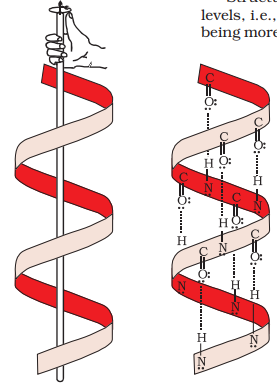
Fig. 10.1: a-Helix structure of proteins
(i) Primary structure of proteins: Proteins may have one or more polypeptide chains. Each polypeptide in a protein has amino acids linked with each other in a specific sequence and it is this sequence of amino acids that is said to be the primary structure of that protein. Any change in this primary structure i.e., the sequence of amino acids creates a different protein.
(ii) Secondary structure of proteins: The secondary structure of protein refers to the shape in which a long polypeptide chain can exist. They are found to exist in two different types of structures viz. $\alpha$-helix and $\beta$-pleated sheet structure. These structures arise due to the regular folding of the backbone of the polypeptide chain due to hydrogen bonding between $\underset{-\mathrm{C}-}{\mathrm{|}}$ and $-\mathrm{NH}$ - groups of the peptide bond.
$\alpha$-Helix is one of the most common ways in which a polypeptide chain forms all possible hydrogen bonds by twisting into a right handed screw (helix) with the -NH group of each amino acid residue hydrogen bonded to the $\triangle \mathrm{C}=\mathrm{O}$ of an adjacent turn of the helix as shown in Fig.14.1.
In $\beta$-pleated sheet structure all peptide chains are stretched out to nearly maximum extension and then laid side by side which are held together by intermolecular hydrogen bonds. The structure resembles the pleated folds of drapery and therefore is known as $\beta$-pleated sheet.
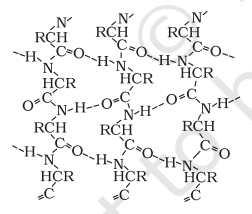
Fig. 10.2: $\beta$-Pleated sheet structure of proteins
(iii) Tertiary structure of proteins: The tertiary structure of proteins represents overall folding of the polypeptide chains i.e., further folding of the secondary structure. It gives rise to two major molecular shapes viz. fibrous and globular. The main forces which stabilise the $2^{\circ}$ and $3^{\circ}$ structures of proteins are hydrogen bonds, disulphide linkages, van der Waals and electrostatic forces of attraction.
(iv) Quaternary structure of proteins: Some of the proteins are composed of two or more polypeptide chains referred to as sub-units. The spatial arrangement of these subunits with respect to each other is known as quaternary structure.
A diagrammatic representation of all these four structures is given in Figure 14.3 where each coloured ball represents an amino acid.
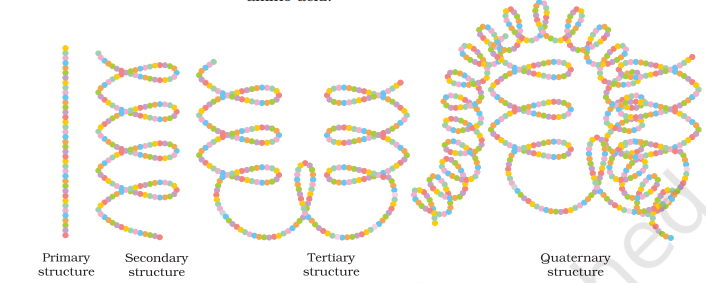
Fig. 10.3: Diagrammatic representation of protein structure (two sub-units of two types in quaternary structure)
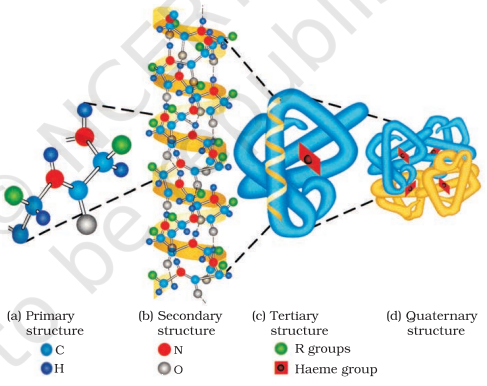
Fig. 10.4: Primary, secondary, tertiary and quaternary structures of haemoglobin
14.2.4 Denaturation of Proteins
Protein found in a biological system with a unique three-dimensional structure and biological activity is called a native protein. When a protein in its native form, is subjected to physical change like change in temperature or chemical change like change in pH, the hydrogen bonds are disturbed. Due to this, globules unfold and helix get uncoiled and protein loses its biological activity. This is called denaturation of protein. During denaturation secondary and tertiary structures are destroyed but primary structure remains intact. The coagulation of egg white on boiling is a common example of denaturation. Another example is curdling of milk which is caused due to the formation of lactic acid by the bacteria present in milk.
Intext Questions
14.4 The melting points and solubility in water of amino acids are generally higher than that of the corresponding halo acids. Explain.
Show Answer
Answer
Both acidic (carboxyl) as well as basic (amino) groups are present in the same molecule of amino acids. In aqueous solutions, the carboxyl group can lose a proton and the amino group can accept a proton, thus giving rise to a dipolar ion known as a zwitter ion.

Due to this dipolar behaviour, they have strong electrostatic interactions within them and with water. But halo-acids do not exhibit such dipolar behaviour.
For this reason, the melting points and the solubility of amino acids in water is higher than those of the corresponding halo-acids.
14.5 Where does the water present in the egg go after boiling the egg?
Show Answer
Answer
When an egg is boiled, the proteins present inside the egg get denatured and coagulate. After boiling the egg, the water present in it is absorbed by the coagulated protein through $\mathrm{H}$-bonding.
14.3 Enzymes
Life is possible due to the coordination of various chemical reactions in living organisms. An example is the digestion of food, absorption of appropriate molecules and ultimately production of energy. This process involves a sequence of reactions and all these reactions occur in the body under very mild conditions. This occurs with the help of certain biocatalysts called enzymes. Almost all the enzymes are globular proteins. Enzymes are very specific for a particular reaction and for a particular substrate. They are generally named after the compound or class of compounds upon which they work. For example, the enzyme that catalyses hydrolysis of maltose into glucose is named as maltase.

Sometimes enzymes are also named after the reaction, where they are used. For example, the enzymes which catalyse the oxidation of one substrate with simultaneous reduction of another substrate are named as oxidoreductase enzymes. The ending of the name of an enzyme is -ase.
14.3.1 Mechanism of Enzyme Action
Enzymes are needed only in small quantities for the progress of a reaction. Similar to the action of chemical catalysts, enzymes are said to reduce the magnitude of activation energy. For example, activation energy for acid hydrolysis of sucrose is $6.22 \mathrm{~kJ} \mathrm{~mol}^{-1}$, while the activation energy is only $2.15 \mathrm{~kJ} \mathrm{~mol}^{-1}$ when hydrolysed by the enzyme, sucrase. Mechanism for the enzyme action has been discussed in Unit 5.
14.4 Vitamins
It has been observed that certain organic compounds are required in small amounts in our diet but their deficiency causes specific diseases. These compounds are called vitamins. Most of the vitamins cannot be synthesised in our body but plants can synthesise almost all of them, so they are considered as essential food factors. However, the bacteria of the gut can produce some of the vitamins required by us. All the vitamins are generally available in our diet. Different vitamins belong to various chemical classes and it is difficult to define them on the basis of structure. They are generally regarded as organic compounds required in the diet in small amounts to perform specific biological functions for normal maintenance of optimum growth and and health of the organism. Vitamins are designated by alphabets A, B, C, D, etc. Some of them are further named as sub-groups e.g. $B_{1}$, $\mathrm{B_2}, \mathrm{~B_6}, \mathrm{~B_12}$, etc. Excess of vitamins is also harmful and vitamin pills should not be taken without the advice of doctor.
The term “Vitamine” was coined from the word vital + amine since the earlier identified compounds had amino groups. Later work showed that most of them did not contain amino groups, so the letter ‘e’ was dropped and the term vitamin is used these days.
14.4.1 Classification of Vitamins
Vitamins are classified into two groups depending upon their solubility in water or fat.
(i) Fat soluble vitamins: Vitamins which are soluble in fat and oils but insoluble in water are kept in this group. These are vitamins A, $\mathrm{D}, \mathrm{E}$ and $\mathrm{K}$. They are stored in liver and adipose (fat storing) tissues.
(ii) Water soluble vitamins: $\mathrm{B}$ group vitamins and vitamin $\mathrm{C}$ are soluble in water so they are grouped together. Water soluble vitamins must be supplied regularly in diet because they are readily excreted in urine and cannot be stored (except vitamin $\mathrm{B_12}$ ) in our body. Some important vitamins, their sources and diseases caused by their deficiency are listed in Table 14.3.
Table 14.3: Some important Vitamins, their Sources and their Deficiency Diseases
| Serial No. | Name of Vitamins |
Sources | Deficiency diseases |
|---|---|---|---|
| 1. | Vitamin $\mathrm{A}$ | Fish liver oil, carrots, butter and milk |
$\mathrm{X}$ e roph th a $1 \mathrm{~m}$ i a (hardening of cornea of eye) Night blindness |
| 2. | Vitamin $B_1$ (Thiamine) |
Yeast, milk, green vegetables and cereals |
Beri beri (loss of appe- tite, retarded growth) |
| 3. | Vitamin $\mathrm{B}_2$ (Riboflavin) |
Milk, eggwhite, liver, kidney |
Cheilosis (fissuring at corners of mouth and lips), digestive disorders and burning sensation of the skin. |
| 4. | Vitamin $B_6$ (Pyridoxine) |
Yeast, milk, egg yolk, cereals and grams |
Convulsions |
| 5. | Vitamin $B_{12}$ | Meat, fish, egg and curd |
Pernicious anaemia (RBC deficient in haemoglobin) |
| 6. | Vitamin C (Ascorbic acid) |
Citrus fruits, amla and green leafy vegetables |
Scurvy (bleeding gums) |
| 7. | Vitamin D | Exposure to sunlight, fish and egg yolk |
Rickets (bone deformities in children) and osteo- malacia (soft bones and joint pain in adults) |
| 8. | Vitamin E | Vegetable oils like wheat germ oil, sunflower oil, etc. |
Increased fragility of RBCs and muscular weakness |
| 9. | Vitamin K | Green leafy vegetables | Increased blood clotting time |
14.5 Nucleic Acids
Every generation of each and every species resembles its ancestors in many ways. How are these characteristics transmitted from one generation to the next? It has been observed that nucleus of a living cell is responsible for this transmission of inherent characters, also called heredity. The particles in nucleus of the cell, responsible for heredity, are called chromosomes which are made up of proteins and another type of biomolecules called nucleic acids. These are mainly of two types, the deoxyribonucleic acid (DNA) and ribonucleic acid (RNA). Since nucleic acids are long chain polymers of nucleotides, so they are also called polynucleotides.
James Dewey Watson
Born in Chicago, Illinois, in 1928, Dr Watson received his Ph.D. (1950) from Indiana University in Zoology. He is best known for his discovery of the structure of DNA for which he shared with Francis Crick and Maurice Wilkins the 1962 Nobel prize in Physiology and Medicine. They proposed that DNA molecule takes the shape of a double helix, an elegantly simple structure that resembles a gently twisted ladder. The rails of the ladder are made of alternating units of phosphate and the sugar deoxyribose; the rungs are each composed of a pair of purine/ pyrimidine bases. This research laid the foundation for the emerging field of molecular biology. The complementary pairing of nucleotide bases explains how identical copies of parental DNA pass on to two daughter cells. This research launched a revolution in biology that led to modern recombinant DNA techniques.
14.5.1 Chemical Composition of Nucleic Acids
Complete hydrolysis of DNA (or RNA) yields a pentose sugar, phosphoric acid and nitrogen containing heterocyclic compounds (called bases). In DNA molecules, the sugar moiety is $\beta$-D-2-deoxyribose whereas in RNA molecule, it is $\beta$-D-ribose.
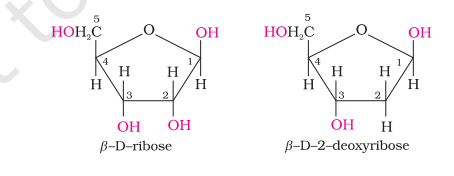
DNA contains four bases viz. adenine (A), guanine (G), cytosine (C) and thymine (T). RNA also contains four bases, the first three bases are same as in DNA but the fourth one is uracil (U).
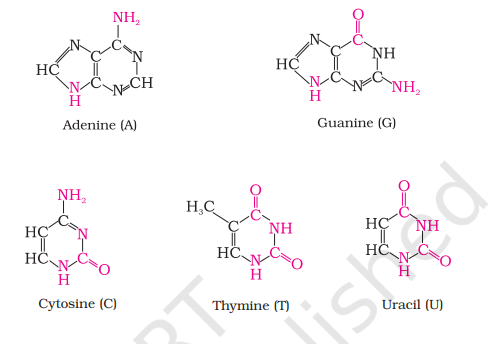
14.5.2 Structure of Nucleic Acids
A unit formed by the attachment of a base to $1^{\prime}$ position of sugar is known as nucleoside. In nucleosides, the sugar carbons are numbered as $1^{\prime}, 2^{\prime}, 3^{\prime}$, etc. in order to distinguish these from the bases (Fig. 14.5a). When nucleoside is linked to phosphoric acid at $5^{\prime}$-position of sugar moiety, we get a nucleotide (Fig. 14.5).

Fig. 10.5: Structure of (a) a nucleoside and (b) a nucleotide
Nucleotides are joined together by phosphodiester linkage between 5¢ and 3¢ carbon atoms of the pentose sugar. The formation of a typical dinucleotide is shown in Fig. 14.6.
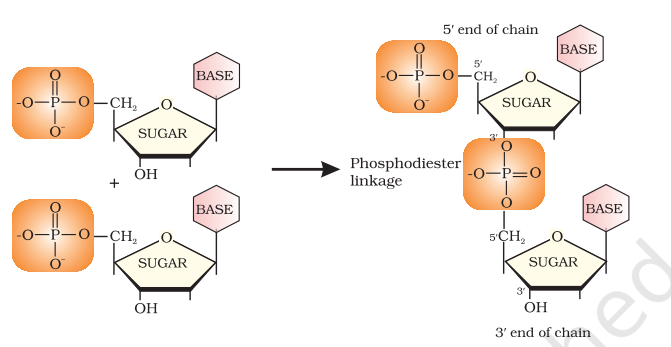
Fig. 10.6: Formation of a dinucleotide
A simplified version of nucleic acid chain is as shown below.
Information regarding the sequence of nucleotides in the chain of a nucleic acid is called its primary structure. Nucleic acids have a secondary structure also. James Watson and Francis Crick gave a double strand helix structure for DNA (Fig. 14.7). Two nucleic acid chains are wound about each other and held together by hydrogen bonds between pairs of bases. The two strands are complementary to each other because the hydrogen bonds are formed between specific pairs of bases. Adenine forms hydrogen bonds with thymine whereas cytosine forms hydrogen bonds with guanine.
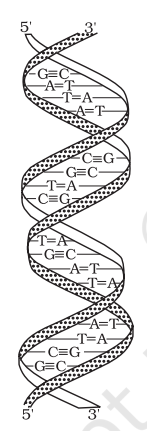
Fig. 10.7: Double strand helix structure for DNA
In secondary structure of RNA single stranded helics is present which sometimes foldsback on itself. RNA molecules are of three types and they perform different functions. They are named as messenger RNA (m-RNA), ribosomal RNA (r-RNA) and transfer RNA (t-RNA).
Har Gobind Khoran

Har Gobind Khorana, was born in 1922. He obtained his M.Sc. degree from Punjab University in Lahore. He worked with Professor Vladimir Prelog, who moulded Khorana’s thought and philosophy towards science, work and effort. After a brief stay in India in 1949, Khorana went back to England and worked with Professor G.W. Kenner and Professor A.R.Todd. It was at Cambridge, U.K. that he got interested in both proteins and nucleic acids. Dr Khorana shared the Nobel Prize for Medicine and Physiology in 1968 with Marshall Nirenberg and Robert Holley for cracking the genetic code.
14.5.3 Biological Functions of Nucleic Acids
DNA is the chemical basis of heredity and may be regarded as the reserve of genetic information. DNA is exclusively responsible for maintaining the identity of different species of organisms over millions of years. A DNA molecule is capable of self duplication during cell division and identical DNA strands are transferred to daughter cells. Another important function of nucleic acids is the protein synthesis in the cell. Actually, the proteins are synthesised by various RNA molecules in the cell but the message for the synthesis of a particular protein is present in DNA.
DNA Fingerprinting
It is known that every individual has unique fingerprints. These occur at the tips of the fingers and have been used for identification for a long time but these can be altered by surgery. A sequence of bases on DNA is also unique for a person and information regarding this is called DNA fingerprinting. It is same for every cell and cannot be altered by any known treatment. DNA fingerprinting is now used
(i) in forensic laboratories for identification of criminals.
(ii) to determine paternity of an individual.
(iii) to identify the dead bodies in any accident by comparing the DNA’s of parents or children.
(iv) to identify racial groups to rewrite biological evolution.
14.6 Hormones
Hormones are molecules that act as intercellular messengers. These are produced by endocrine glands in the body and are poured directly in the blood stream which transports them to the site of action.
In terms of chemical nature, some of these are steroids, e.g., estrogens and androgens; some are poly peptides for example insulin and endorphins and some others are amino acid derivatives such as epinephrine and norepinephrine.
Hormones have several functions in the body. They help to maintain the balance of biological activities in the body. The role of insulin in keeping the blood glucose level within the narrow limit is an example of this function. Insulin is released in response to the rapid rise in blood glucose level. On the other hand hormone glucagon tends to increase the glucose level in the blood. The two hormones together regulate the glucose level in the blood. Epinephrine and norepinephrine mediate responses to external stimuli. Growth hormones and sex hormones play role in growth and development. Thyroxine produced in the thyroid gland is an iodinated derivative of amino acid tyrosine. Abnormally low level of thyroxine leads to hypothyroidism which is characterised by lethargyness and obesity. Increased level of thyroxine causes hyperthyroidism. Low level of iodine in the diet may lead to hypothyroidism and enlargement of the thyroid gland. This condition is largely being controlled by adding sodium iodide to commercial table salt (“Iodised” salt).
Steroid hormones are produced by adrenal cortex and gonads (testes in males and ovaries in females). Hormones released by the adrenal cortex play very important role in the functions of the body. For example, glucocorticoids control the carbohydrate metabolism, modulate inflammatory reactions, and are involved in reactions to stress. The mineralocorticoids control the level of excretion of water and salt by the kidney. If adrenal cortex does not function properly then one of the results may be Addison’s disease characterised by hypoglycemia, weakness and increased susceptibility to stress. The disease is fatal unless it is treated by glucocorticoids and mineralocorticoids. Hormones released by gonads are responsible for development of secondary sex characters. Testosterone is the major sex hormone produced in males. It is responsible for development of secondary male characteristics (deep voice, facial hair, general physical constitution) and estradiol is the main female sex hormone. It is responsible for development of secondary female characteristics and participates in the control of menstrual cycle. Progesterone is responsible for preparing the uterus for implantation of fertilised egg.
Intext Questions
14.6 Why cannot vitamin C be stored in our body?
Show Answer
Answer
Vitamin $\mathrm{C}$ cannot be stored in our body because it is water soluble. As a result, it is readily excreted in the urine.
14.7 What products would be formed when a nucleotide from DNA containing thymine is hydrolysed?
Show Answer
Answer
When a nucleotide from the DNA containing thymine is hydrolyzed, thymine $\beta$-D-2-deoxyribose and phosphoric acid are obtained as products.
14.8 When RNA is hydrolysed, there is no relationship among the quantities of different bases obtained. What does this fact suggest about the structure of RNA?
Show Answer
Answer
A DNA molecule is double-stranded in which the pairing of bases occurs. Adenine always pairs with thymine, while cytosine always pairs with guanine. Therefore, on hydrolysis of DNA, the quantity of adenine produced is equal to that of thymine and similarly, the quantity of cytosine is equal to that of guanine.
But when RNA is hydrolyzed, there is no relationship among the quantities of the different bases obtained. Hence, RNA is single-stranded.
Summary
Carbohydrates are optically active polyhydroxy aldehydes or ketones or molecules which provide such units on hydrolysis. They are broadly classified into three groups monosaccharides, disaccharides and polysaccharides. Glucose, the most important source of energy for mammals, is obtained by the digestion of starch. Monosaccharides are held together by glycosidic linkages to form disaccharides or polysaccharides.
Proteins are the polymers of about twenty different $\alpha$-amino acids which are linked by peptide bonds. Ten amino acids are called essential amino acids because they cannot be synthesised by our body, hence must be provided through diet. Proteins perform various structural and dynamic functions in the organisms. Proteins which contain only $\alpha$-amino acids are called simple proteins. The secondary or tertiary structure of proteins get disturbed on change of $\mathrm{pH}$ or temperature and they are not able to perform their functions. This is called denaturation of proteins. Enzymes are biocatalysts which speed up the reactions in biosystems. They are very specific and selective in their action and chemically majority of enzymes are proteins.
Vitamins are accessory food factors required in the diet. They are classified as fat soluble (A, D, E and K) and water soluble (B group and C). Deficiency of vitamins leads to many diseases.
Nucleic acids are the polymers of nucleotides which in turn consist of a base, a pentose sugar and phosphate moiety. Nucleic acids are responsible for the transfer of characters from parents to offsprings. There are two types of nucleic acids DNA and RNA. DNA contains a five carbon sugar molecule called 2-deoxyribose whereas RNA contains ribose. Both DNA and RNA contain adenine, guanine and cytosine. The fourth base is thymine in DNA and uracil in RNA. The structure of DNA is a double strand whereas RNA is a single strand molecule. DNA is the chemical basis of heredity and have the coded message for proteins to be synthesised in the cell. There are three types of RNA - mRNA, rRNA and tRNA which actually carry out the protein synthesis in the cell.
Exercises
14.1 What are monosaccharides?
Show Answer
Answer
Monosaccharides are carbohydrates that cannot be hydrolysed further to give simpler units of polyhydroxy aldehyde or ketone.
Monosaccharides are classified on the bases of number of carbon atoms and the functional group present in them. Monosaccharides containing an aldehyde group are known as aldoses and those containing a keto group are known as ketoses. Monosaccharides are further classified as trioses, tetroses, pentoses, hexoses, and heptoses according to the number of carbon atoms they contain. For example, a ketose containing 3 carbon atoms is called ketotriose and an aldose containing 3 carbon atoms is called aldotriose.
14.2 What are reducing sugars?
Show Answer
Answer
Reducing sugars are carbohydrates that reduce Fehling’s solution and Tollen’s reagent. All monosaccharides and disaccharides, excluding sucrose, are reducing sugars.
14.3 Write two main functions of carbohydrates in plants.
Show Answer
Answer
Two main functions of carbohydrates in plants are:
(i) Polysaccharides such as starch serve as storage molecules.
(ii) Cellulose, a polysaccharide, is used to build the cell wall.
14.4 Classify the following into monosaccharides and disaccharides. Ribose, 2-deoxyribose, maltose, galactose, fructose and lactose.
Show Answer
Answer
Monosaccharides:
Ribose, 2-deoxyribose, galactose, fructose
Disaccharides:
Maltose, lactose
14.5 What do you understand by the term glycosidic linkage?
Show Answer
Answer
Glycosidic linkage refers to the linkage formed between two monosaccharide units through an oxygen atom by the loss of a water molecule.
For example, in a sucrose molecule, two monosaccharide units, $\alpha$-glucose and $\beta$-fructose, are joined together by a glycosidic linkage.

14.6 What is glycogen? How is it different from starch?
Show Answer
Answer
Glycogen is a carbohydrate (polysaccharide). In animals, carbohydrates are stored as glycogen.
Starch is a carbohydrate consisting of two components - amylose (15 - 20%) and amylopectin (80 - 85%).
However, glycogen consists of only one component whose structure is similar to amylopectin. Also, glycogen is more branched than amylopectin.
14.7 What are the hydrolysis products of
(i) sucrose and
(ii) lactose?
Show Answer
Answer
(i) On hydrolysis, sucrose gives one molecule of $\alpha-D$ glucose and one molecule of $\beta$ - D-fructose.

(ii) The hydrolysis of lactose gives $\beta$-D-galactose and $\beta$-D-glucose.

14.8 What is the basic structural difference between starch and cellulose?
Show Answer
Answer
Starch consists of two components - amylose and amylopectin. Amylose is a long linear chain of $\alpha-D-(+)$-glucose units joined by C1-C4 glycosidic linkage ( $\alpha$-link).

Amylopectin is a branched-chain polymer of $\alpha$-D-glucose units, in which the chain is formed by C1-C4 glycosidic linkage and the branching occurs by C1-C6 glycosidic linkage.

On the other hand, cellulose is a straight-chain polysaccharide of $\beta$-D-glucose units joined by C1-C4 glycosidic linkage ($\beta$-link).

14.9 What happens when D-glucose is treated with the following reagents?
(i) $\mathrm{HI}$
(ii) Bromine water
(iii) $\mathrm{HNO_3}$
Show Answer
Answer
(i) When D-glucose is heated with $\mathrm{HI}$ for a long time, $\mathrm{n}$-hexane is formed.

(ii) When D-glucose is treated with $\mathrm{Br_2}$ water, D- gluconic acid is produced.

(iii) On being treated with $\mathrm{HNO_3}$, D-glucose get oxidised to give saccharic acid.

14.10 Enumerate the reactions of D-glucose which cannot be explained by its open chain structure.
Show Answer
Answer
(1) Aldehydes give 2, 4-DNP test, Schiff’s test, and react with $\mathrm{NaHSO_4}$ to form the hydrogen sulphite addition product. However, glucose does not undergo these reactions.
(2) The pentaacetate of glucose does not react with hydroxylamine. This indicates that a free - $\mathrm{CHO}$ group is absent from glucose.
(3) Glucose exists in two crystalline forms - $\alpha$ and $\beta$. The $\alpha$-form (m.p. $=419 \mathrm{~K}$ ) crystallises from a concentrated solution of glucose at $303 \mathrm{~K}$ and the $\beta$-form (m.p $=423 \mathrm{~K}$ ) crystallises from a hot and saturated aqueous solution at $371 \mathrm{~K}$. This behaviour cannot be explained by the open chain structure of glucose.
14.11 What are essential and non-essential amino acids? Give two examples of each type.
Show Answer
Answer
Essential amino acids are required by the human body, but they cannot be synthesised in the body. They must be taken through food. For example: valine and leucine
Non-essential amino acids are also required by the human body, but they can be synthesised in the body. For example: glycine, and alanine
14.12 Define the following as related to proteins
(i) Peptide linkage
(ii) Primary structure
(iii) Denaturation.
Show Answer
Answer
(i) Peptide linkage:
The amide formed between $-\mathrm{COOH}$ group of one molecule of an amino acid and $-\mathrm{NH_2}$ group of another molecule of the amino acid by the elimination of a water molecule is called a peptide linkage.

(ii) Primary structure:
The primary structure of protein refers to the specific sequence in which various amino acids are present in it, i.e., the sequence of linkages between amino acids in a polypeptide chain. The sequence in which amino acids are arranged is different in each protein. A change in the sequence creates a different protein.
(iii) Denaturation:
In a biological system, a protein is found to have a unique 3-dimensional structure and a unique biological activity. In such a situation, the protein is called native protein. However, when the native protein is subjected to physical changes such as change in temperature or chemical changes such as change in $\mathrm{pH}$, its $\mathrm{H}$-bonds are disturbed. This disturbance unfolds the globules and uncoils the helix. As a result, the protein loses its biological activity. This loss of biological activity by the protein is called denaturation. During denaturation, the secondary and the tertiary structures of the protein get destroyed, but the primary structure remains unaltered.
One of the examples of denaturation of proteins is the coagulation of egg white when an egg is boiled.
14.13 What are the common types of secondary structure of proteins?
Show Answer
Answer
There are two common types of secondary structure of proteins:
(i) $\propto$-helix structure
(ii) $\beta$-pleated sheet structure
$\alpha$ - Helix structure:
In this structure, the $-\mathrm{NH}$ group of an amino acid residue forms $\mathrm{H}$-bond with the $ \rangle \mathrm{C=O}$ group of the adjacent turn of the right-handed screw ( $\alpha$-helix).

$\beta$-pleated sheet structure:
This structure is called so because it looks like the pleated folds of drapery. In this structure, all the peptide chains are stretched out to nearly the maximum extension and then laid side by side. These peptide chains are held together by intermolecular hydrogen bonds.

14.14 What type of bonding helps in stabilising the $\alpha$-helix structure of proteins?
Show Answer
Answer
The H-bonds formed between the - $\mathrm{NH}$ group of each amino acid residue and the $\rangle {\mathrm{C}}=\mathrm{O}$ group of the adjacent turns of the $\alpha$-helix help in stabilising the helix.
14.15 Differentiate between globular and fibrous proteins.
Show Answer
Answer
| Fibrous protein | Globular protein | ||
|---|---|---|---|
| 1. | It is a fibre-like structure formed by the polypeptide chain. These proteins are held together by strong hydrogen and disulphide bonds. | 1. | The polypeptide chain in this protein is folded around itself, giving rise to a spherical structure. |
| 2. | It is usually insoluble in water. | 2. | It is usually soluble in water. |
| 3. | Fibrous proteins are usually used for structural purposes. For example, keratin is present in nails and hair; collagen in tendons; and myosin in muscles. | 3. | All enzymes are globular proteins. Some hormones such as insulin are also globular proteins. |
14.16 How do you explain the amphoteric behaviour of amino acids?
Show Answer
Answer
In aqueous solution, the carboxyl group of an amino acid can lose a proton and the amino group can accept a proton to give a dipolar ion known as zwitter ion.

Therefore, in zwitter ionic form, the amino acid can act both as an acid and as a base.

Thus, amino acids show amphoteric behaviour.
14.17 What are enzymes?
Show Answer
Answer
Enzymes are proteins that catalyse biological reactions. They are very specific in nature and catalyse only a particular reaction for a particular substrate. Enzymes are usually named after the particular substrate or class of substrate and some times after the particular reaction.
For example, the enzyme used to catalyse the hydrolysis of maltose into glucose is named as maltase.
$ \underset{\text{Maltose}}{\mathrm{C_{12}} \mathrm{H_22} \mathrm{O_{11}}} \xrightarrow{\text { Maltase }} \underset{\text{Glucose}}{2 \mathrm{C_6} \mathrm{H_{12}} \mathrm{O_6}} $
Again, the enzymes used to catalyse the oxidation of one substrate with the simultaneous reduction of another substrate are named as oxidoreductase enzymes.
The name of an enzyme ends with ’ - ase'.
14.18 What is the effect of denaturation on the structure of proteins?
Show Answer
Answer
As a result of denaturation, globules get unfolded and helixes get uncoiled. Secondary and tertiary structures of protein are destroyed, but the primary structures remain unaltered. It can be said that during denaturation, secondary and tertiary-structured proteins get converted into primary-structured proteins. Also, as the secondary and tertiary structures of a protein are destroyed, the enzyme loses its activity.
14.19 How are vitamins classified? Name the vitamin responsible for the coagulation of blood.
Show Answer
Answer
On the basis of their solubility in water or fat, vitamins are classified into two groups.
(i) Fat-soluble vitamins: Vitamins that are soluble in fat and oils, but not in water, belong to this group. For example: Vitamins A, D, E, and K
(ii) Water-soluble vitamins:Vitamins that are soluble in water belong to this group. For example: $\mathrm{B}$ group vitamins ( $\mathrm{B_1}, \mathrm{~B_2}, \mathrm{~B_6}, \mathrm{~B_{12}}$, etc.) and vitamin $\mathrm{C}$
However, biotin or vitamin $\mathrm{H}$ is neither soluble in water nor in fat.
Vitamin $\mathrm{K}$ is responsible for the coagulation of blood.
14.20 Why are vitamin A and vitamin C essential to us? Give their important sources.
Show Answer
Answer
The deficiency of vitamin A leads to xerophthalmia (hardening of the cornea of the eye) and night blindness. The deficiency of vitamin C leads to scurvy (bleeding gums).
The sources of vitamin A are fish liver oil, carrots, butter, and milk. The sources of vitamin C are citrus fruits, amla, and green leafy vegetables.
14.21 What are nucleic acids? Mention their two important functions.
Show Answer
Answer
Nucleic acids are biomolecules found in the nuclei of all living cells, as one of the constituents of chromosomes. There are mainly two types of nucleic acids - deoxyribonucleic acid (DNA) and ribonucleic acid (RNA). Nucleic acids are also known as polynucleotides as they are long-chain polymers of nucleotides.
Two main functions of nucleic acids are:
(i) DNA is responsible for the transmission of inherent characters from one generation to the next. This process of transmission is called heredity.
(ii) Nucleic acids (both DNA and RNA) are responsible for protein synthesis in a cell. Even though the proteins are actually synthesised by the various RNA molecules in a cell, the message for the synthesis of a particular protein is present in DNA.
14.22 What is the difference between a nucleoside and a nucleotide?
Show Answer
Answer
A nucleoside is formed by the attachment of a base to $\mathrm{l}^{\prime}$ position of sugar.
Nucleoside $=$ Sugar + Base

On the other hand, all the three basic components of nucleic acids (i.e., pentose sugar, phosphoric acid, and base) are present in a nucleotide.
Nucleotide $=$ Sugar + Base + Phosphoric acid

Structure of a nucleotide
14.23 The two strands in DNA are not identical but are complementary. Explain.
Show Answer
Answer
In the helical structure of DNA, the two strands are held together by hydrogen bonds between specific pairs of bases. Cytosine forms hydrogen bond with guanine, while adenine forms hydrogen bond with thymine. As a result, the two strands are complementary to each other.
14.24 Write the important structural and functional differences between DNA and RNA.
Show Answer
Answer
The structural differences between DNA and RNA are as follows:
| DNA | RNA | ||
|---|---|---|---|
| 1. | The sugar moiety in DNA molecules is $\beta$-D-2 deoxyribose. | 1. | The sugar moiety in RNA molecules is $\beta$-D-ribose. |
| 2. | DNA contains thymine (T). It does not contain uracil (U). | 2. | RNA contains uracil (U). It does not contain thymine (T). |
| 3. | The helical structure of DNA is double-stranded. | 3. | The helical structure of RNA is single- stranded. |
The functional differences between DNA and RNA are as follows:
| DNA | RNA | ||
|---|---|---|---|
| 1 | DNA is the chemical basis of heredity. | 1 | RNA is not responsible for heredity. |
| 2 | DNA molecules do not synthesise proteins, but transfer coded | 2 | Proteins are synthesised by RNA |
message for the synthesis of proteins in the cells. molecules in the cells.
14.25 What are the different types of RNA found in the cell?
Show Answer
Answer
(i) Messenger RNA (m-RNA)
(ii) Ribosomal RNA (r-RNA)
(iii) Transfer RNA (t-RNA)
यह शरीर की रासायनिक अभिक्रियाओं की सुव्यवस्थित एवं समक्रमिक और समकालिक प्रगति है जो जीवन को प्रेरित करती है।
एक जैव-तंत्र स्वयं वृद्धि करता है, कायम रहता है तथा स्वयं का पुनर्जनन करता है। जैव-तंत्र की सबसे आश्चर्यजनक बात यह है कि यह अजैविक परमाणुओं तथा अणुओं से मिलकर बनता है। जीवित तंत्र में रसायनतः क्या होता है? इसके ज्ञान का अनुसरण जैव रसायन के क्षेत्र के अंतर्गत आता है। जैव-तंत्र अनेक जटिल जैव अणु जैसे कार्बोहाइड्रेट, प्रोटीन, न्यूक्लीक अम्ल, लिपिड आदि से मिलकर बनते हैं। प्रोटीन तथा कार्बोहाइड्रेट हमारे भोजन के आवश्यक अवयव हैं। ये जैव अणु आपस में अन्योन्यक्रिया करते हैं तथा जैव-प्रणाली का आण्विक आधार बनाते हैं। इसके अतिरिक्त कुछ सरल अणु जैसे विटामिन और खनिज लवण भी जीवों की कार्य-प्रणालियों में महत्वपूर्ण भूमिका निभाते हैं। इनमें से कुछ जैव अणुओं की संरचनाएं एवं कार्य प्रणालियों की विवेचना इस एकक में की गई है।
10.1 कर्बोहाइड्रेट
कार्बोहाइड्रेट मुख्यतया पौधों द्वारा उत्पन्न किए जाते हैं तथा प्राकृतिक कार्बनिक यौगिकों का वृहत समूह बनाते हैं। कार्बोहाइड्रेट के कुछ सामान्य उदाहरण इक्षु-शर्करा, ग्लूकोस तथा स्टार्च (मंड) आदि हैं। इनमें से अधिकांश का सामान्य सूत्र $\mathrm{C} _{\mathrm{x}}\left(\mathrm{H} _{2} \mathrm{O}\right) _{\mathrm{y}}$, होता है तथा पहले इन्हें कार्बन के हाइड्रेट माना जाता था जिसके कारण इनका नाम कार्बोहाइड्रेट व्युत्पन्न हुआ। उदाहरणार्थ ग्लूकोस का सूत्र $\left(\mathrm{C} _{6} \mathrm{H} _{12} \mathrm{O} _{6}\right)$ यहाँ दिए सामान्य सूत्र $\mathrm{C} _{6}\left(\mathrm{H} _{2} \mathrm{O}\right) _{6}$ के अनुरूप है। परंतु वे सभी यौगिक जो इस सूत्र के अनुरूप हैं, कार्बोहाइड्रेट के रूप में वर्गीकृत नहीं किए जा सकते। जैसे कि ऐसीटिक अम्ल $\left(\mathrm{CH} _{3} \mathrm{COOH}\right)$ का सूत्र इस सामान्य सूत्र $\mathrm{C} _{2}\left(\mathrm{H} _{2} \mathrm{O}\right) _{2}$ में सही बैठता है परंतु यह कार्बोहाइड्रेट नहीं है। इसी प्रकार रैम्नोस $\left(\mathrm{C} _{6} \mathrm{H} _{12} \mathrm{O} _{5}\right)$ एक कार्बोहाइड्रेट है परंतु इस परिभाषा में सही नहीं बैठता। अधिकांश अभिक्रियाएं यह प्रदर्शित करती हैं कि इनमें एक विशिष्ट प्रकार्यात्मक समूह होता है। रासायनिक रूप से, कार्बोहाइड्रेटों को ध्रुवण घूर्णक पॉलिहाइड्रॉक्सी ऐल्डिहाइड अथवा कीटोन अथवा उन यौगिकों की तरह परिभाषित किया जा सकता है जो जलअपघटन के उपरांत इस प्रकार की इकाइयाँ देते हैं। कुछ कार्बोहाइड्रेटों को जो स्वाद में मीठे होते हैं, शर्करा कहते हैं। घरेलू उपयोग में आने वाली सामान्य शर्करा को सूक्रोस कहते हैं। जबकि दुगध में पाए जाने वाली शर्करा को दुगध-शर्करा या लैक्टोस कहते हैं। कार्बोहाइड्रेटों को सैकैराइड भी कहते हैं [ग्रीक; सैकेरॉन (Sekcharon) का तात्पर्य शर्करा है]।
10.1.1 कार्बोहाइड्रेट वर्गीकरण
कार्बोहाइड्रेटों को जलअपघटन में उनके व्यवहार के आधार पर मुख्यतः निम्नलिखित तीन वर्गों में वर्गीकृत किया गया है।
(i) मोनोसैकैराइड- वे कार्बोहाइड्रेट जिसको पॉलिहाइड्राक्सी ऐल्डिहाइड अथवा कीटोन के और अधिक सरल यौगिकों में जल अपघटित नहीं किया जा सकता, मोनोसैकैराइड कहलाते हैं। लगभग 20 मोनोसैकैराइड प्रकृति में ज्ञात हैं। इसके कुछ सामान्य उदाहरण ग्लूकोस, फ्रक्टोज़, राइबोस आदि हैं।
(ii) ओलिगोसैकैराइड- वे कार्बोहाइड्रेट जिनके जलअपघटन से मोनोसैकैराइड की दो से दस तक इकाइयाँ प्राप्त होती हैं, ओलिगोसैकैराइड कहलाते हैं। जलअपघटन से प्राप्त मोनोसैकैराइडों की संख्या के आधार पर इन्हें पुन: डाइसैकैराइड, ट्राइसैकैराइड, टेट्रासैकैराइड आदि में वर्गीकृत किया गया है। इनमें से डाइसैकैराइड प्रमुख हैं। डाइसैकैराइड के जलअपघटन से प्राप्त दो मोनोसैकैराइड इकाइयाँ समान अथवा भिन्न हो सकती हैं। उदाहरणार्थ, सूक्रोस का एक अणु जल अपघटन द्वारा ग्लूकोस व फ्रक्टोज़ की एक-एक इकाई देता है, जबकि माल्टोस से प्राप्त दोनों इकाइयाँ केवल ग्लूकोस की होती हैं।
(iii) पॉलिसैकैराइड- वे कार्बोहाइड्रेट जिनके जल अपघटन पर अत्यधिक संख्या में मोनोसैकैराइड इकाइयाँ प्राप्त होती हैं, पॉलिसैकैराइड कहलाते हैं। इसके कुछ प्रमुख उदाहरण स्टार्च, सेलुलोस, ग्लाइकोजन तथा गोंद आदि हैं। पॉलिसैकैराइड स्वाद में मीठे नहीं होते अतः इन्हें अशर्करा भी कहते हैं।
कार्बोहाइड्रेट को अपचायी एवं अनपचायी शर्करा में भी वर्गीकृत किया जा सकता है। उन सभी कार्बोहाइड्रेटों को जो फेलिंग विलयन तथा टॉलेन अभिकर्मक को अपचित कर देते हैं, अपचायी शर्करा कहा जाता है। सभी मोनोसैकैराइड चाहे वे ऐल्डोस हों अथवा कीटोस, अपचायी शर्करा होती है।
10.1.2 मोनोसैकैराइड
कार्बन परमाणुओं की संख्या एवं प्रकार्यात्मक समूह के आधार पर मोनोसैकैराइड को पुन: वर्गीकृत किया जा सकता है। यदि मोनोसैकैराइड में ऐल्डिहाइड समूह है तो उसे ऐल्डोस और यदि उसमें कीटो समूह है तो उसे कीटोस कहते हैं। मोनोसैकैराइड में निहित कार्बन परमाणुओं की संख्या को भी नाम में सम्मिलित किया जाता है जो कि सारणी 10.1 में दिए गए उदाहरणों से स्पष्ट है-
सारणी 10.1- विभिन्न प्रकार के मोनोसैकैराइड
| कार्बन परमाणु | सामान्य पद | ऐल्डिहाइड | कीटोन |
|---|---|---|---|
| 3 | ट्रायोस | ऐल्डोट्रायोस | कीटोट्रायोस |
| 4 | टेट्रोस | ऐल्डोटेट्रोस | कीटोटेट्रोस |
| 5 | पेन्टोस | ऐल्डोपेन्टोस | कीटोपेन्टोस |
| 6 | हैक्सोज | ऐल्डोहैक्सोज | कीटो हैक्सोस |
| 7 | हेप्टोस | ऐल्डोहैप्टोस | कीटोहैप्टोस |
10.1.2.1 ग्लूकोस
ग्लूकोस प्रकृति में मुक्त अथवा संयुक्त अवस्था में मिलता है। यह मीठे फलों तथा शहद में उपस्थित होता है। पके हुए अंगूर में भी बहुत अधिक मात्रा में ग्लूकोस होता है। इसे निम्नानुसार बनाया जा सकता है।
ग्लूकोस को बनाने की विधियाँ
1. सूक्रोस (इक्षु-शर्करा) से- सूक्रोस को तनु $\mathrm{HCl}$ अथवा $\mathrm{H} _{2} \mathrm{SO} _{4}$ के साथ ऐल्कोहॉलिक विलयन में क्वथन करने पर ग्लूकोस तथा फ्रक्टोज़ समान मात्रा में प्राप्त होते हैं।
$$ \begin{aligned} & \underset{\text { सूक्रोस} }{\mathrm{C} _{12} \mathrm{H} _{22} \mathrm{O} _{11}} +\mathrm{H} _2 \mathrm{O} \xrightarrow{\mathrm{H}^{+}} \underset{ \text { ग्लूकोस } }{\mathrm{C} _6 \mathrm{H} _{12} \mathrm{O} _6}+ \underset{ \text { फ्रक्टोज़ } }{\mathrm{C} _6 \mathrm{H} _{12} \mathrm{O} _6} \end{aligned} $$
2. स्टार्च से- औद्योगिक स्तर पर ग्लूकोस को स्टार्च के जल अपघटन से प्राप्त किया जाता है। इसके लिए स्टार्च को तनु $\mathrm{H} _{2} \mathrm{SO} _{4}$ के साथ $393 \mathrm{~K}$ दाब पर क्वथन किया जाता है।
$$ \underset{\text { स्टार्च अथवा सेलुलोस }}{\left(\mathrm{C_6} \mathrm{H_10} \mathrm{O_5}\right)_{\mathrm{n}}}+\mathrm{nH_2} \mathrm{O} \xrightarrow[\text { 393K; 2-3} \mathrm{ वायु-दाब} ] {[\mathrm{H}^{+}]} \underset{ \text{ग्लूकोस} }{\mathrm{nC_6} \mathrm{H_12} \mathrm{O_6} } $$
ग्लूकोस की संरचना
ग्लूकोस एक ऐल्डोहैक्सोस है तथा इसे डेक्सट्रोस कहते हैं। यह अनेक कार्बोहाइड्रेटों यथा स्टार्च, सेलुलोस आदि का एकलक होता है। यह संभवतः पृथ्वी पर बहुतायत में पाया जाने वाला कार्बनिक यौगिक है। निम्नलिखित प्रमाणों के आधार पर यह संरचना दिए गए चित्र के अनुसार प्रदर्शित की जा सकती है-
1. इसका आण्विक सूत्र $\mathrm{C} _{6} \mathrm{H} _{12} \mathrm{O} _{6}$ पाया गया।

2. $\mathrm{HI}$ के साथ लंबे समय तक गरम करने पर यह $\mathrm{n}-$ हैक्सेन देता है जो यह प्रदर्शित करता है कि सभी छः कार्बन परमाणु एक ऋजु शृंखला में जुड़े हैं।

3. ग्लूकोस, हाइड्रॉक्सिल ऐमीन के साथ अभिक्रिया करने पर एक ऑक्सिम देता है तथा हाइड्रोजन सायनाइड के एक अणु से संयोग कर सायनोहाइड्रिन देता है। ये अभिक्रियाएं ग्लूकोस में कार्बोनिल समूह $(>\mathrm{C}=\mathrm{O})$ की उपस्थिति की पुष्टि करती हैं।

4. ग्लूकोस ब्रोमीन जल जैसे दुर्बल ऑक्सीकरण कर्मक द्वारा ऑक्सीकरण से छः कार्बन परमाणुयुक्त कार्बोक्सिलिक अम्ल (ग्लूकोनिक अम्ल) देता है। यह सिद्ध करता है कि ग्लूकोस का कार्बोनिल समूह ऐल्डिहाइड समूह के रूप में उपस्थित है।

5. ग्लूकोस के ऐसीटिक ऐनहाइड्राइड द्वारा ऐसीटिलन से ग्लूकोस पेन्टाऐसीटेट बनाता है जो ग्लूकोस में पाँच $-\mathrm{OH}$ समूहों की उपस्थिति की पुष्टि करता है। चूँकि ग्लूकोस स्थायी यौगिक है, अतः पाँच $-\mathrm{OH}$ समूह भिन्न-भिन्न कार्बन परमाणु से जुड़े होने चाहिए।
6. ग्लूकोस तथा ग्लूकोनिक अम्ल दोनों ही नाइट्रिक अम्ल द्वारा ऑक्सीकरण से एक डाइकार्बोक्सिलिक अम्ल, सैकैरिक अम्ल बनाते हैं। यह ग्लूकोस में प्राथमिक ऐल्कोहॉलिक समूह की उपस्थिति को दर्शाता है।

बहुत से अन्य अनेक गुणों के अध्ययन के उपरांत फिशर ने विभिन्न - $\mathrm{OH}$ समूहों की सही दिक्-स्थान व्यवस्था को दर्शाया। इसका सही विन्यास संरचना I द्वारा निरूपित होता है। ग्लूकोनिक अम्ल को संरचना II तथा सैकेरिक अम्ल को संरचना III द्वारा निरूपित करते हैं।

ग्लूकोस को सही रूप में $\mathrm{D}(+)$ - ग्लूकोस नाम देते हैं। ग्लूकोस के नाम से पहले लिखा ’ $\mathrm{D}$ ’ इसके विन्यास को निरूपित करता है जबकि ’ $(+)$ ’ अणु की दक्षिण ध्रुवण घूर्णकता को निरूपित करता है। यह स्मरणीय है कि ’ $\mathrm{D}$ ’ व ’ $\mathrm{L}$ ’ का, यौगिक की ध्रुवण घूर्णकता से कोई संबंध नहीं है एवं इनका शब्द ’ $d$ ’ तथा ’ $\mathrm{l}$ ’ से भी कोई संबंध नहीं है (एकक-6 देखें) ’ $\mathrm{D}$ ’ व ’ $L$ ’ संकेत चिह्नों का अर्थ नीचे दिया गया है।
किसी यौगिक के नाम से पहले लिखे अक्षर $\mathrm{D}$ व $\mathrm{L}$ उसके किसी विशेष यौगिक के त्रिविम समावयवी के किसी अन्य यौगिक जिसका विन्यास ज्ञात हो के आपेक्षिक विन्यास को प्रदर्शित करते हैं। कार्बोहाइड्रेटों में यह संबंध ग्लिसरैल्डिहाइड के किसी विशेष समावयवी से दर्शाया जाता है। ग्लिसंरैल्डिहाइड में एक असममित कार्बन परमाणु होता है तथा इसके दो प्रतिबिंब रूप होते हैं जिन्हें निम्न प्रकार से दर्शाया जा सकता है-

ग्लिसरैलिडहाइड के $(+)$ समावयवी का विन्यास ’ $\mathrm{D}$ ’ होता है (इसका अर्थ है कि जब हम विशेष नियमों का अनुसरण करते हुए, जिन्हें आप आगे की कक्षाओं में पढ़ेंगे, इसकी संरचना कागज पर लिखते हैं तो संरचना में-OH समूह दाहिनी ओर होता है। वे सभी यौगिक जिनका सहसंबंध रासायनिक रूप से ग्लिसरैल्डिहाइड के $\mathrm{D}(+)$ समावयवी से स्थापित किया जा सकता है, D-विन्यास वाले कहलाते हैं। जबकि वे जिनका सहसंबंध ग्लिसरैल्डिहाइड के $\mathrm{L}(-)$ समावयवी से स्थापित किया जा सकता है $\mathrm{L}$-विन्यास वाले ग्लूकोस कहलाते हैं। आप संरचना में देख सकते हैं कि $\mathrm{L}(-)$ समावयवी में $-\mathrm{OH}$ समूह बायीं ओर है। किसी मोनोसैकैराइड के विन्यास के निर्धारण के लिए इसके सबसे नीचे वाले असममित कार्बन परमाणु (जैसा कि नीचे दर्शाया गया है) की तुलना करते हैं जैसे कि (+) ग्लूकोस में सबसे नीचे वाले असममित कार्बन परमाणु में $-\mathrm{OH}$ समूह दाईं ओर है जिसकी तुलना $\mathrm{D}(+)$ ग्लिसरैल्डिाहाइड से की जा सकती है अतः (+) ग्लूकोस का विन्यास $\mathrm{D}$ निर्धरित किया जाता है। ग्लूकोस के अन्य असममित कार्बनों पर इस तुलना में ध्यान नहीं देते। इस तुलना के लिए संरचना को इस प्रकार लिखा जाता है कि सर्वाधिक ऑक्सीकृत कार्बन परमाणु (यहाँ - $\mathrm{CHO}$ ) शीर्ष पर रहे।

ग्लूकोस की चक्रीय संरचना
संरचना I ग्लूकोस के अधिकांश गुणों को स्पष्ट करती है परंतु निम्नलिखित अभिक्रियाएं एवं तथ्य इस संरचना द्वारा स्पष्ट नहीं होते।
1. ऐल्डिहाइड समूह उपस्थित होते हुए भी ग्लूकोस शिफ-परीक्षण नहीं देता एवं यह $\mathrm{NaHSO} _{3}$ के साथ हाइड्रोजन सल्फाइड योगज उत्पाद नहीं बनाता।
2. ग्लूकोस का पेन्टाऐसीटेट, हाइड्रॉक्सिलऐमीन के साथ अभिक्रिया नहीं करता जो मुक्त $-\mathrm{CHO}$ समूह की अनुपस्थिति को इंगित करता है।
3. ग्लूकोस दो भिन्न क्रिस्टलीय रूपों में पाया जाता है जिन्हें $\alpha$ तथा $\beta$ कहते हैं। ग्लूकोस का $\alpha$ रूप (गलनांक $419 \mathrm{~K}$ ) इसके सांद्र विलयन से $303 \mathrm{~K}$ ताप पर क्रिस्टलीकरण द्वारा प्राप्त किया जाता है जबकि ग्लूकोस का $\beta$ रूप (गलनांक $423 \mathrm{~K}$ ) $371 \mathrm{~K}$ पर ग्लूकोस के गरम एवं संतृप्त विलयन से इसके क्रिस्टलीकरण से प्राप्त किया जाता है।
ग्लूकोस की विवृत श्रृंखला संरचना (I) द्वारा उपरोक्त व्यवहार को नहीं समझाया जा सकता। यह सुझाव दिया गया कि $-\mathrm{OH}$ समूहों में से एक, $-\mathrm{CHO}$ समूह से योगज द्वारा चक्रीय हैमीऐसीटैल संरचना बनाता है। यह पाया गया कि ग्लूकोस एक छः सदस्यीय वलय बनाता है जिसमें $\mathrm{C}-5$ पर उपस्थित $-\mathrm{OH}$ समूह वलय निर्माण करता है। यह - $\mathrm{CHO}$ समूह की अनुपस्थिति एवं ग्लूकोस के निम्नानुसार दर्शाए गए दो रूपों के अस्तित्व को समझाता है। ये दोनों चक्रीय रूप ग्लूकोस की विवृत शृंखला के साथ साम्य में रहते हैं।

ग्लूकोस के दोनों चक्रीय हैमीऐसीटैल रूपों में भिन्नता केवल $\mathrm{C} _{1}$ पर उपस्थित हाइड्रॉक्सिल समूह के विन्यास में होती है। इसे ऐनोमरी कार्बन (चक्रीकरण से पूर्व ऐल्डीहाइड कार्बन) कहते हैं। ऐसे समावयवी अर्थात $\alpha$ तथा $\beta$ रूपों को ऐनोमर कहते हैं। पाइरैन से समानता के होने के कारण ग्लूकोस की छः सदस्यीय वलय वाली संरचना को पाइरैनोस संरचना $(\alpha$ या $\beta)$ कहते हैं। पाइरैन एक ऑक्सीजन तथा पाँच कार्बन परमाणुयुक्त चक्रीय सरंचना है। ग्लूकोस की चक्रीय संरचना को अधिक सही रूप में नीचे दी गई हावर्थ संरचना द्वारा निरूपित किया जा सकता है।

10.1.2.2 फ्रक्टोज़ ( फल शर्करा )
फ्रक्टोज़ एक महत्वपूर्ण कीटोहैक्सोस है। यह डाइसैकैराइड, सूक्रोस के जलअपघटन पर ग्लूकोस के साथ प्राप्त होता है। फ्रक्टोज़ एक प्राकृतिक मोनोसैकैराइड है जो कि फलों एवं सब्ज़ियों में पाया जाता है। शुद्ध अवस्था में मधुरक के रूप में प्रयोग होता है।
फ्रक्टोज़ की संरचना
फ्रक्टोज़ का अणुसूत्र भी $\mathrm{C} _{6} \mathrm{H} _{12} \mathrm{O} _{6}$ होता है। इसकी रासायनिक अभिक्रियाओं के आधार पर यह पाया गया कि फ्रक्टोस में कार्बन संख्या 2 पर एक कीटोनिक समूह है तथा ग्लूकोस के समान छः कार्बन परमाणुओं की एक ऋजु श्रृंखला है। यह D- श्रेणी से संबंधित है तथा वामु ध्रुवण घूर्णक यौगिक है। इसे उपयुक्त रूप से $\mathrm{D}-(-)$ फ्रक्टोज़ लिखा जा सकता है। यहाँ इसकी विवृत श्रृंखला संरचना दी गई है।
यह भी दो चक्रीय संरचनाओं में उपस्थित रहता है जो $\mathrm{C} _{5}$ पर उपस्थित $-\mathrm{OH}$ तथा $(>\mathrm{C}=0$ ) के योगज से प्राप्त होती है। इस प्रकार पाँच सदस्यीय वलय बनती है तथा फ्यूरान से समानता के कारण इसे फ्यूरेनोस कहा जाता है। फ्यूरान एक पाँच सदस्यीय वलय संरचना है जिसमें एक ऑक्सीजन परमाणु तथा चार कार्बन परमाणु होते हैं।

फ्रक्टोज़ के दोनों ऐनोमर की चक्रीय संरचना को हावर्थ संरचनाओं द्वारा निम्न प्रकार से निरूपित किया जाता है-

10.1.3 डाइसैकैराइड
हम पहले पढ़ चुके हैं कि डाइसैकैराइडों का तनु अम्ल अथवा एन्जाइम की उपस्थिति में जलअपघटन द्वारा समान अथवा असमान मोनोसैकैराइडों के दो अणु देते हैं। दोनों मोनोसैकैराइड इकाइयाँ, जल के एक अणु के निष्कासन के उपरांत बने ऑक्साइड बंध द्वारा जुड़ी रहती हैं। परमाणु के द्वारा दो मोनोसैकैराइड इकाइयों में इस प्रकार के आबंध को ग्लाइकोसाइडी बंध कहते हैं।
यदि डाइसैकैराइड में मोनोसैकैराइडों के अपचायी समूह जैसे ऐल्डिहाइड अथवा कीटोन आबंधित हों तो वह अनअपचायी शर्करा होती है। उदाहरणार्थ सूक्रोस। दूसरी ओर यदि शर्करा में ये प्रकार्यात्मक समूह मुक्त हों तो यह अपचायी शर्करा कहलाती है। उदाहरणार्थ- माल्टोस तथा लेक्टोस।
I. सूक्रोस- सूक्रोस एक सामान्य डाइसैकैराइड है जो जलअपघटन पर सममोलर (equimolar) मात्रा में $\mathrm{D}-(+)$-ग्लूकोस तथा $\mathrm{D}-(-)$ फ्रक्टोज़ देता है।
$$ \underset{\text { सूक्रोस }}{\mathrm{C} _{12}} \mathrm{H} _{22} \mathrm{O} _{11}+\mathrm{H} _{2} \mathrm{O} \longrightarrow \underset{\text { D-(+)-ग्लूकोस }}{\mathrm{C} _{6} \mathrm{H} _{12} \mathrm{O} _{6}}+\underset{\substack{\text { D-(-)-फ्रक्टोज़ }}}{\mathrm{C} _{6} \mathrm{H} _{12} \mathrm{O} _{6}} $$
ये दोनों मोनोसैकैराइड इकाइयाँ $\alpha-\mathrm{D}$-ग्लूकोस के $\mathrm{C} _{1}$ तथा $\beta-\mathrm{D}$-फ्रक्टोज़ के $\mathrm{C} _{2}$ के मध्य ग्लाइकोसाइडी बंध द्वारा जुड़ी रहती हैं। चूँकि ग्लूकोस तथा फ्रक्टोज़ का अपचायक समूह ग्लाइकोसाइडी बंध निर्माण में प्रयुक्त होता है अतः सूक्रोस एक अनअपचायी शर्करा है।

सूक्रोस दक्षिण ध्रुवण घूर्णक होती है। लेकिन जल अपघटन के उपरांत दक्षिण ध्रुवण घूर्णक ग्लूकोस तथा वामु घ्रुवण घूर्णक फ्रक्टोज़ देता है। चूंकि फ्रक्टोज़ के वामु ध्रुवण घूर्णन का मान $\left(-92.4^{\circ}\right)$, ग्लूकोस के दक्षिण ध्रुवण घूर्णन $\left(+52.5^{\circ}\right)$, से अधिक होता है। अतः जलअपघटन पर सूक्रोस के घूर्णन के चिह्न में परिवर्तन दक्षिण $(+)$ से वाम $(-)$ में हो जाता है तथा उत्पाद को अपवृत शर्करा कहा जाता है।
II माल्टोस- एक अन्य डाइसैकैराइड माल्टोस $\alpha$-D-ग्लूकोस की दो इकाइयों से निर्मित होता है जिसमें एक ग्लूकोस इकाई का $\mathrm{C} _{1}$ दूसरी ग्लूकोस इकाई के $\mathrm{C} _{4}$ के साथ जुड़ा रहता है विलयन में ग्लूकोस की दूसरी इकाई का $\mathrm{C} _{1}$ मुक्त ऐल्डिहाइड समूह देता है। यह अपचायक गुण दर्शाता है अतः यह एक अपचायी शर्करा है।

III लैक्टोस- लैक्टोस दुग्ध में उपस्थित होने के कारण सामान्यतः दुग्ध शर्करा भी कहलाती है। यह $\beta$-[D]-गैलैक्टोस तथा $\beta$-[D]-ग्लूकोस से निर्मित होती है। गैलैक्टोस के $\mathrm{C} _{1}$ तथा ग्लूकोस के $\mathrm{C} _{4}$ के मध्य बंध होता है। मुक्त एल्डिहाइड ग्लूकोस इकाई के $\mathrm{C}-1$ पर उत्पन्न हो सकता है। अतः यह भी एक अपचायी शर्करा है।

10.1.4 पॉलिसैकैराइड
पॉलिसैकैराइड में असंख्य मोनोसैकैराइड इकाइयाँ ग्लाइकोसाइडी बंध द्वारा संयुक्त रहती हैं। यह प्रकृति में सर्वाधिक पाए जाने वाले कार्बोहाइड्रेट हैं। यह मुख्यतः भोजन संग्रहण तथा संरचना निर्माण का कार्य करते हैं।
I. स्टार्च- स्टार्च पौधों में मुख्य संग्रहित पॉलिसैकैराइड है। यह मनुष्यों के लिए आहार का मुख्य स्रोत है। दाल, जड़, कंद तथा कुछ सब्ज़ियों में स्टार्च प्रचुर मात्रा में मिलता है। यह $\alpha$-ग्लूकोस का बहुलक है तथा दो घटकों ऐमिलोस तथा ऐमिलोपेक्टिन से मिलकर बनता है। ऐमिलोस जल में घुलनशील अवयव है तथा यह स्टार्च का $15-20 \%$ भाग निर्मित करता है। रासायनिक रूप से ऐमिलोस 200-1000 $\alpha-\mathrm{D}-(+)$-ग्लूकोस इकाइयों की अशाखित शृंखला होती है जो आपस में $\mathrm{C} _{1}-\mathrm{C} _{4}$ ग्लाइकोसाइडी बंध द्वारा जुड़ी रहती हैं।
ऐमिलोपेक्टिन जल में अविलेय होती है तथा यह स्टार्च का $80-85 \%$ भाग बनाती हैं। यह $\alpha$-D-ग्लूकोस इकाइयों की शाखित श्रृंखला होती है, जिसमें $\mathrm{C} _{1}-\mathrm{C} _{4}$ ग्लाइकोसाइडी बंध होते हैं। जबकि शाखन $\mathrm{C} _{1}-\mathrm{C} _{6}$ ग्लाइकोसाइडी बंध द्वारा होता है।


II. सेलुलोस- सेलुलोस विशिष्ट रूप से केवल पौधों में मिलता है तथा यह वनस्पति जगत में प्रचुरता में उपलब्ध कार्बनिक पदार्थ है। यह पौधों की कोशिकाओं की कोशिका भित्ति का प्रधान अवयव है। सेलुलोस, $\beta$-D-ग्लूकोस से बनी ऋजु शृंखला युक्त पॉलिसैकैराइड है जिसमें एक ग्लूकोस इकाई के $\mathrm{C} _{1}$ तथा दूसरी ग्लूकोस इकाई के $\mathrm{C} _{4}$ के मध्य ग्लाइकोसाइडी बंध बनता है।

III. ग्लाइकोजन- प्राणी शरीर में कार्बोहाइड्रेट, ग्लाइकोजन के रूप में संग्रहित रहता है। चूँकि इसकी संरचना ऐमिलोपेक्टिन के समान होती है, अतः इसे प्राणी स्टार्च भी कहा जाता है एवं यह ऐमिलोपेक्टिन से अधिक शाखित होता है। यह यकृत, मांसपेशियों तथा मस्तिष्क में उपस्थित रहता है। जब शरीर को ग्लूकोस की आवश्यकता होती है, एन्जाइम, ग्लाइकोजन को ग्लूकोस में तोड़ देते हैं। ग्लाइकोजन यीस्ट तथा कवक में भी मिलता है।
10.1.5 कार्बोहाइड्रेटों का महत्व
कार्बोहाइड्रेट पौधों तथा प्राणियों में जीवन के लिए आवश्यक होते हैं। ये हमारे भोजन का प्रमुख भाग होते हैं। चिकित्सा की आयुर्वेद प्रणाली में ऊर्जा में तात्कालिक स्रोत के रूप में वैद्यों द्वारा शहद का उपयोग किया जाता रहा है। कार्बोहाइड्रेट अणु वनस्पतियों में स्टार्च के रूप में एवं जंतुओं में ग्लाइकोजन के रूप में संचित होते हैं। जीवाणुओं एवं पौधों की कोशिका भित्ति सेलुलोस की बनी होती है। लकड़ी के रूप में प्राप्त सेलुलोस से हम फ़र्नीचर आदि बनाते हैं तथा सूती रेशों के रूप में प्राप्त सेलुलोस से हमारे वस्त्र बनते हैं। अनेक प्रमुख उद्योगों जैसे वस्त्र, कागज़, प्रलाक्ष (लैकर), निसवन (मद्यनिर्माण) उद्योग इत्यादि के लिए इनसे कच्चा माल उपलब्ध होता है।
न्युक्लीक अम्ल में दो ऐल्डोपेन्टोस यथा $\mathrm{D}$-राइबोस तथा 2 -डीऑक्सीराइबोस उपस्थित होती हैं। जैव-तंत्र में कार्बोहाइड्रेट अनेक प्रोटीनों तथा लिपिडों के साथ संयुक्तावस्था में मिलते हैं।
पाठ्यनिहित प्रश्न
10.1 ग्लूकोस तथा सूक्रोस जल में विलेय हैं जबकि साइक्लोहैक्सेन अथवा बेन्ज़ीन (सामान्य छः सदस्यीय वलय युक्त यौगिक) जल में अविलेय होते हैं। समझाइए।
Show Answer
#missing10.2 लैक्टोस के जलअपघटन से किन उत्पादों के बनने की अपेक्षा करते हैं?
Show Answer
#missing10.3 $\mathrm{D}$-ग्लूकोस के पेन्टाऐसीटेट में आप ऐल्डिहाइड समूह की अनुपस्थिति को कैसे समझाएंगे?
Show Answer
#missing10.2 प्रोटीन
( $\mathrm{R}=$ पार्श्व शृंखला) प्रोटीन जीव जगत में सर्वाधिक पाए जाने वाले जैव अणु हैं। प्रोटीन के प्रमुख स्रोत दूध, पनीर, दालें, मूँगफली, मछली तथा मांस आदि हैं। यह शरीर के प्रत्येक भाग में उपस्थित होते हैं तथा जीवन का मूलभूत संरचनात्मक एवं क्रियात्मक आधार बनाते हैं। यह शरीर की वृद्धि, एवं अनुरक्षण के लिए भी आवश्यक होते हैं। प्रोटीन शब्द की व्युत्पत्ति ग्रीक शब्द ‘प्रोटियोस’ से हुई है जिसका अर्थ प्राथमिक अथवा अतिमहत्वपूर्ण होता है। सभी प्रोटीन $\alpha$-ऐमीनो अम्लों के बहुलक होते हैं।
10.2.1 ऐमीनो अम्ल
ऐमीनो अम्ल में ऐमीनो $\left(-\mathrm{NH} _{2}\right)$ तथा कार्बोक्सिल $(-\mathrm{COOH})$ प्रकार्यात्मक समूह उपस्थित होते हैं। कार्बोक्सिल समूह के संदर्भ में ऐमीनो समूह की आपेक्षिक स्थितियों के आधार पर ऐमीनो अम्लों को $\alpha, \beta, \gamma, \delta$ आदि में वर्गीकृत किया जा सकता है। प्रोटीन के जलअपघटन से केवल $\alpha$ - ऐमीनो अम्ल ही प्राप्त होते हैं। इनमें अन्य प्रकार्यात्मक समूह भी उपस्थित हो सकते हैं।
सभी ऐमीनो अम्लों के रूढ़ नाम हैं जो इन यौगिकों के गुण अथवा इनके स्रोत को प्रदर्शित करते हैं। ग्लाइसीन को उसका नाम मीठे स्वाद के कारण दिया गया है। ग्रीक भाषा में ग्लाइकोस (glykos) का अर्थ मीठा होता है तथा टाइरोसीन सर्वप्रथम पनीर से प्राप्त किया गया था (ग्रीक भाषा में टाइरोस (tyros) का अर्थ पनीर है)। प्रत्येक ऐमीनो अम्ल को साधारणतः एक तीन अक्षर प्रतीक द्वारा प्रदर्शित किया जाता है। कभी-कभी एक अक्षर प्रतीक का उपयोग भी किया जाता है। सामान्यतः उपलब्ध-ऐमीनो अम्लों की संरचनाएं एवं उनके 3 -अक्षर व 1 -अक्षर प्रतीक सारणी 10.2 में दिए गए हैं।

10.2.2 ऐमीनो अम्लों का वर्गीकरण
ऐमीनो अम्लों को उनके अणुओं में उपस्थित ऐमीनो तथा कार्बोक्सिल समूहों की आपेक्षिक संख्या के आधार पर अम्लीय, क्षारकीय अथवा उदासीन वर्गों में वर्गीकृत किया गया है। ऐमीनो तथा कार्बोक्सिल समूहों की समान संख्या ऐमीनो अम्ल की प्रकृति को उदासीन बनाती है। कार्बोक्सिल समूहों की अपेक्षा ऐमीनो समूहों को संख्या अधिक होने पर यह क्षारकीय तथा कार्बोक्सिल समूहों की संख्या ऐमीनो समूहों की संख्या से अधिक होने पर यह अम्लीय होते हैं जो ऐमीनो अम्ल शरीर में संश्लेषित हो सकते हैं उन्हें अनावश्यक ऐमीनो अम्ल कहते हैं जबकि वे ऐमीनो अम्ल जो शरीर में संश्लेषित नहीं हो सकते तथा जिनको भोजन में लेना आवश्यक है, आवश्यक ऐमीनो अम्ल कहलाते हैं (सारणी 10.2 में तारक द्वारा चिह्नित)।
ऐमीनो अम्ल सामान्यतः रंगहीन क्रिसलीय ठोस होते हैं। ये जल-विलेय तथा उच्च गलनांकी ठोस होते हैं जो सामान्य ऐमीनो तथा कार्बोक्सिलिक अम्लों की भाँति व्यवहार नहीं करते, अपितु लवणों की भाँति गुण दर्शाते हैं। इसका कारण एक ही अणु में अम्लीय (कार्बोक्सिल समूह) तथा क्षारकीय (ऐमीनो समूह) समूहों की उपस्थिति है। जलीय विलयन में कार्बोक्सिल समूह एक प्रोटॉन मुक्त कर सकता है जबकि ऐमीनो समूह एक प्रोटॉन ग्रहण कर सकता है जिसके फलस्वरूप एक द्विध्रुवीय आयन बनता है जिसे ज़्विटर आयन अथवा उभयाविष्ट आयन कहते हैं। यह उदासीन होता है परंतु इसमें धनावेश तथा ॠणावेश दोनों ही उपस्थित हैं।

उभयाविष्ट आयनिक रूप में ऐमीनो अम्ल उभयधर्मी प्रकृति दर्शाते हैं। तथा वे अम्लों एवं क्षारकों दोनों के साथ अभिक्रिया करते हैं।
ग्लाइसीन के अतिरिक्त अन्य सभी प्रकृति में उपलब्ध ऐमीनो अम्ल ध्रुवण घूर्णक होते हैं क्योंकि इनमें $\alpha$-कार्बन परमाणु असममित होता है। ये ’ $\mathrm{D}$ ’ तथा ’ $\mathrm{L}$ ’ दोनों रूपों में पाए जाते हैं। अधिकांश प्राकृतिक ऐमीनो अम्लों का विन्यास ’ $\mathrm{L}$ ’ होता है। $\mathrm{L}$-ऐमीनो अम्लों को $-\mathrm{NH} _{2}$ समूह को बाईं ओर लिखकर प्रदर्शित किया जाता है।
10.2.3 प्रोटीनों की संरचना
आप पहले पढ़ चुके हैं कि प्रोटीन $\alpha$-ऐमीनो अम्लों के बहुलक होते हैं जो आपस में पेप्टाइड आबंध अथवा पेप्टाइड बंध द्वारा जुड़े रहते हैं। रासायनिक रूप से पेप्टाइड आबंध, $-\mathrm{COOH}$ समूह तथा $-\mathrm{NH} _{2}$ समूह के मध्य बना एक आबंध होता है। दो एक जैसे अथवा भिन्न ऐमीनो अम्लों के अणुओं के मध्य अभिक्रिया एक अणु के ऐमीनो समूह तथा दूसरे अणु के कार्बोक्सिल समूह के मध्य संयोग से होती है। जिसके फलस्वरूप एक जल का अणु मुक्त होता है तथा पेप्टाइड आबंध $-\mathrm{CO}-\mathrm{NH}-$ बनता है। चूँकि उत्पाद दो ऐमीनो अम्लों के द्वारा बनता है अतः इसे डाइपेप्टाइड कहते हैं। उदाहरणार्थ, जब ग्लाइसीन का कार्बोक्सिल समूह, ऐलानीन के ऐमीनो समूह के साथ संयोग करता है तो हमें एक डाइपेप्टाइड, ग्लाइसिलऐलेनीन प्राप्त होता है।

यदि तीसरा ऐमीनो अम्ल, डाइपेप्टाइड से संयोग करता है तो उत्पाद ट्राइपेप्टाइड कहलाता है। एक ट्राइपेप्टाइड में तीन ऐमीनो अम्ल होते हैं जो दो पेप्टाइड बंधों द्वारा संयुक्त रहते हैं। इसी प्रकार से जब चार, पाँच, अथवा छः एमीनो अम्ल आपस में जुड़ते हैं तो परिणामी उत्पादों को ग्लाइसिलएलनीन (Gly-Ala) टेट्रापेप्टाइड, पेन्टापेप्टाइड अथवा हैक्सापेप्टाइड कहते हैं। जब ऐमीनो अम्लों की संख्या दस से अधिक होती है तो उत्पाद पॉलिपेप्टाइड कहलाते हैं। एक पॉलिपेप्टाइड जिसमें 100 से अधिक ऐमीनो अम्ल अवशेष होते हैं तथा जिनका आण्विक द्रव्यमान $10,000 \mathrm{u}$ से अधिक होता है, प्रोटीन कहलाता है। यद्यपि, प्रोटीन तथा पॉलिपेप्टाइड में यह विभेद अधिक सुस्पष्ट नहीं है। कम ऐमीनों अम्ल वाले पॉलिपेप्टाइडों को भी प्रोटीन कहने की संभावना होती है यदि उनमें प्रोटीन जैसा सुस्पष्ट संरूपण हो जैसा कि इन्सुलिन में होता है जिसमें 51 ऐमीनो अम्ल होते हैं।
आण्विक आकृति के आधार पर प्रोटीनों को दो वर्गों में वर्गीकृत किया जा सकता है-
( अ) रेशेदार प्रोटीन
जब पॉलिपेप्टाइड शृंखलाएं समानांतर होती हैं तथा हाइड्रोजन एवं डाइसल्फाइड आबंधों द्वारा संयुक्त रहती हैं तो रेशासम (रेशे जैसी) संरचना बनती है। इस प्रकार के प्रोटीन सामान्यतः जल में अविलेय होते हैं। कुछ सामान्य उदाहरण किरेटिन (बाल, ऊन तथा रेशम में उपस्थित) तथा मायोसिन (मांसपेशियों में उपस्थित) आदि हैं।
(ब) गोलिकाकार प्रोटीन
जब पॉलिपेप्टाइड की शृंखलाएं कुंडली बनाकर गोलाकृति प्राप्त कर लेती हैं तो ऐसी संरचनाएं प्राप्त होती हैं ये सामान्यतः जल में विलेय होती है। इन्सुलिन तथा ऐल्बूमिन इनके सामान्य उदाहरण हैं।
प्रोटीनों की संरचना एवं आकृति का अध्ययन चार भिन्न स्तरों पर किया जा सकता है। प्राथमिक, द्वितीयक, तृतीयक एवं चतुष्क संरचनाएं तथा प्रत्येक स्तर पूर्व की तुलना में जटिल होती हैं।

चित्र 10.1 - प्रोटीन की $\alpha$-कुण्डलिनि संरचना
(i) प्रोटीन की प्राथमिक संरचना- प्रोटीनों में एक अथवा अनेक पॉलिपेप्टाइड श्रृंखलाएं उपस्थित हो सकती हैं। किसी प्रोटीन के प्रत्येक पॉलिपेप्टाइड में ऐमीनो अम्ल एक विशिष्ट क्रम में संयुक्त होते हैं। ऐमीनो अम्लों का यह विशिष्ट क्रम प्रोटीनों की प्राथमिक संरचना बनाता है। प्राथमिक संरचना में किसी भी प्रकार का परिवर्तन अर्थात् ऐमीनो अम्लों के क्रम में परिवर्तन से भिन्न प्रोटीन उत्पन्न होते हैं।
(ii) प्रोटीनों की द्वितीयक संरचना- किसी प्रोटीन की द्वितीयक संरचना का संबंध उस आकृति से है जिसमें पॉलिपेप्टाइड भृंखला विद्यमान होती है। यह दो भिन्न प्रकार की संरचनाओं में विद्यमान होती हैं- $\alpha$-हेलिक्स तथा $\beta$-प्लीटेड शीट संरचना। ये संरचनाएं पेप्टाइड आबंध के $-\stackrel{|}{\mathrm{C}}-$ तथा $-\mathrm{NH}-$ समूह के मध्य हाइड्रोजन बंध के कारण पॉलिपेप्टाइड की मुख्य शृंखला के नियमित कुंडलन में उत्पन्न होती हैं।
$\alpha$-हेलिक्स संरचना एक ऐसी संरचना है जिसमें पॉलिपेप्टाइड शृंखला में सभी संभव हाइड्रोजन आबंध बन सकते हैं। इसमें पॉलिपेप्टाइडश्रृंखला दक्षिणावर्ती पेंच के समान मुड़ी रहती है फलस्वरूप प्रत्येक ऐमीनो अम्ल अवशिष्ट का $-\mathrm{NH}$ समूह, कुंडली के अगले मोड़ पर स्थित $-\mathrm{C}=\mathrm{O}$ समूह के साथ हाइड्रोजन आबंध बनाता है जैसा कि चित्र 10.1 में दर्शाया गया है।
$\beta$-संरचना में सभी पॉलिपेप्टाइड शृंखलाएं लगभग अधिकतम विस्तार तक खिंची रहकर एक दूसरे के पार्श्व में स्थित होती हैं तथा आपस में अंतराआण्विक हाइड्रोजन आबंध द्वारा जुड़ी रहती हैं। यह संरचना वस्त्रों में प्लीट के समान होती है अतः इसको $\beta$-प्लीटेड शीट कहते हैं।

चित्र 10.2 - प्रोटीन की $\beta$-प्लीटेड शीट संरचना
(iii) प्रोटीन की तृतीयक संरचना- प्रोटीन की तृतीयक संरचना पॉलिपेप्टाइड शृंखलाओं के समग्र वलन, अर्थात् द्वितीयक संरचना के और अधिक वलन ( लिपटना) को प्रदर्शित करती है। इससे दो प्रमुख आण्विक आकृतियाँ बनती हैंरेशेदार तथा गोलिकाकार। प्रमुख बल जो प्रोटीन की $2^{\circ}$ तथा $3^{\circ}$ संरचनाओं को स्थायित्व प्रदान करते हैं वे हैं- हाइड्रोजन आबंध, डाइसल्फाइड बंध, वान्डर वाल तथा स्थिर विद्युत आकर्षण बल।
(iv) प्रोटीन की चतुष्क संरचना- कुछ प्रोटीन दो या दो से अधिक पॉलिपेटाइड श्रृंखलाओं से बने होते हैं जिन्हें उप-इकाई कहते हैं। इन उप-इकाइयों की परस्पर दिक्-स्थान व्यवस्था को चतुष्क संरचना कहते हैं।
इन चारो संरचनाओं का चित्रात्मक निरूपण चित्र 10.3 में दिया गया है जिसमें प्रत्येक रंगीन गेंद, एक ऐमीनो अम्ल को निरूपित करती है।

चित्र 10.3 - प्रोटीन की संरचनाओं का चित्रात्मक निरूपण (चतुष्क संरचना में दो प्रकार की दो उप इकाइयाँ)

चित्र 10.4 - हीमोग्लोबिन की प्राथमिक, द्वितीयक, तृतीयक एवं चतुष्क संरचनाएं
10.2.4 प्रोटीन का विकृतीकरण
जैविक निकाय में पाई जाने वाली विशेष त्रिविमा संरचना तथा जैविक सक्रियता वाले प्रोटीन, प्राकृत प्रोटीन कहलाता है। जब प्राकृत प्रोटीन में भौतिक परिवर्तन करते हैं, जैसे- ताप में परिवर्तन अथवा रासायनिक परिवर्तन करते हैं जैसे, $\mathrm{pH}$ में परिवर्तन आदि किया जाता है तो हाइड्रोजन आबंधों में अस्तव्यस्तता उत्पन्न हो जाती है। जिसके कारण गोलिका (ग्लोब्यूल) खुल जाती है तथा हैलिक्स अकुंडलित हो जाती है तथा प्रोटीन अपनी जैविक सक्रियता को खो देता है। इसे प्रोटीन का विकृतीकरण कहते हैं। विकृतीकरण के दौरान द्वितीयक तथा तृतीयक संरचनाएं नष्ट हो जाती हैं परंतु प्राथमिक संरचना अप्रभावित रहती है। उबालने पर अंडे की सफ़ेदी का स्कंदन विकृतीकरण का एक सामान्य उदाहरण है। एक अन्य उदाहरण दही का जमना है। जो दूध में उपस्थित बैक्टीरिया द्वारा लेक्टिक अम्ल उत्पन्न होने के कारण होता है।
पाठूयनिहित प्रश्न
10.4 ऐमीनो अम्लों के गलनांक एवं जल में विलेयता सामान्यतः संगत हैलो अम्लों की तुलना में अधिक होती है। समझाइए।
Show Answer
#missing10.5 अंडे को उबालने पर उसमें उपस्थित जल कहाँ चला जाता है?
Show Answer
#missing10.3 एन्जाइम
जीवधारियों में होने वाली विभिन्न रासायनिक अभिक्रियाओं में समन्वयन के कारण ही जीवन संभव है। इसका एक उदाहरणार्थ है भोजन का पाचन, उपयुक्त अणुओं का अवशोषण तथा अंततः ऊर्जा का उत्पादन। इस प्रक्रम में अभिक्रियाएं एक अनुक्रम होती हैं तथा ये सभी अभिक्रियाएं शरीर में मध्यम परिस्थितियों में सम्पन्न होती हैं। यह कुछ जैव उत्प्रेरकों की सहायता से होता है जिन्हें एन्जाइम कहते हैं। लगभग सभी एन्जाइम गोलिकाकार प्रोटीन होते हैं। एन्जाइम किसी विशेष अभिक्रिया अथवा विशेष क्रियाधार के लिए विशिष्ट होते हैं। इनका नामकरण सामान्यतया उस यौगिक अथवा यौगिकों के वर्ग पर आधारित होता है जिस पर ये कार्य करते हैं। उदाहरणार्थ, उस एन्जाइम का नाम माल्टेस है जो माल्टोस के ग्लूकोस में जलअपघटन को उत्प्रेरित करता है।

कभी-कभी एन्जाइम का नाम उस अभिक्रिया के आधार पर दिया जाता है जिसमें इनका उपयोग होता है। उदाहरणार्थ, जो एन्जाइम एक क्रियाधार का ऑक्सीकरण उत्प्रेरित करते हैं तथा साथ ही दूसरे क्रियाधार का अपचयन उन्हें आक्सिडोरिडक्टेस नाम दिया जाता है। एन्जाइम के नाम के अंत में ऐस (-ase) आता है।
10.3.1 एन्जाइम क्रिया की क्रियाविधि
किसी अभिक्रिया की प्रगति के लिए एन्जाइम की बहुत कम मात्रा की आवश्यकता होती है। रासायनिक उत्प्रेरक की क्रिया के समान कहा जाता है कि एन्जाइम, संक्रियण ऊर्जा के परिमाण को कम कर देते हैं। उदाहरणार्थ, सूक्रोस के अम्लीय जलअपघटन के लिए संक्रियण ऊर्जा $6.22 \mathrm{~kJ} \mathrm{~mol}^{-1}$ है जबकि सूक्रेस एन्जाइम द्वारा जल अपघटित होता है तो सक्रियण ऊर्जा केवल $2.15 \mathrm{~kJ} \mathrm{~mol}^{-1}$ होती है।
10.4 विटामिन
ऐसा देखा गया है कि हमारे भोजन में कुछ कार्बनिक यौगिकों की आवश्यकता सूक्ष्म मात्रा में होती है परंतु उनकी कमी के कारण विशेष रोग हो जाते हैं। इन यौगिकों को विटामिन कहते हैं। अधिकांश विटामिनों का संश्लेषण हमारे शरीर द्वारा नहीं किया जा सकता लेकिन पौधे लगभग सभी विटामिनों का संश्लेषण कर सकते हैं, अतः इन्हें आवश्यक आहार कारक माना गया है। यद्यपि आहारनली के बैक्टीरिया हमारे लिए आवश्यक कुछ विटामिनों को उत्पन्न कर सकते हैं। सामान्यतः हमारे आहार में सभी विटामिन उपलब्ध रहते हैं। विभिन्न विटामिन भिन्न श्रेणियों से संबंधित होते हैं, अतः इन्हें संरचना के आधार पर परिभाषित करना कठिन है। इन्हें सामान्यतः इस प्रकार विचारित किया जाता है कि ये विशिष्ट जैविक क्रियाओं के संपन्न होने के लिए हमारे आहार में आवश्यक वे कार्बनिक पदार्थ हैं जिनसे जीव की इष्टतम वृद्धि एवं स्वास्थ्य का सामान्य रखरखाव होता है। विटामिनों को $\mathrm{A}, \mathrm{B}, \mathrm{C}, \mathrm{D}$, आदि अक्षरों के द्वारा निर्दिष्ट किया जाता है इनमें से कुछ को पुनः उपवर्गों उदाहरणार्थ $\mathrm{B} _{1}, \mathrm{~B} _{2}$, $\mathrm{B} _{6}, \mathrm{~B} _{12}$, आदि में नाम दिया गया है। विटामिन का आधिक्य भी हानिकारक होता है, अत: चिकित्सक के परामर्श के बिना विटामिन की गोली नहीं लेनी चाहिए।
विटामिन (vitamine) दो शब्दों- विटल (vital) + ऐमीन (amine) से जुड़कर बना है; क्योंकि प्रारंभ में पहचाने गए यौगिकों में ऐमीनो समूह था। लेकिन बाद के कार्यों से प्रदर्शित हुआ कि इनमें से अधिकांश में ऐमीनो समूह नहीं होता, अतः अंग्रेज़ी में लिखे शब्द का अंतिम अक्षर ’ $e$ ’ हटा दिया गया तथा वर्तमान में विटामिन (vitamin) शब्द का उपयोग किया जाता है।
10.4.1 विटामिनों का वर्गीकरण
जल तथा वसा में विलेयता के आधार पर विटामिनों को दो समूहों में वर्गीकृत किया गया है
(i) वसा विलेय विटामिन- इस वर्ग में उन विटामिनों को रखा गया है जो वसा तथा तेल में विलेय होते हैं परंतु जल में अविलेय। ये विटामिन $\mathrm{A}, \mathrm{D}, \mathrm{E}$ तथा $\mathrm{K}$ हैं। ये यकृत तथा ऐडिपोस (वसा संग्रहित करने वाला) ऊतक में संग्रहित रहते हैं।
(ii) जल में विलेय विटामिन- $B$ वर्ग के विटामिन तथा विटामिन $C$ जल में विलेय होते हैं अतः इन्हें एक साथ इस वर्ग में रखा गया है। जल में विलेय विटामिनों की पूर्ति हमारे आहार में नियमित रूप से होनी चाहिए क्योंकि ये आसानी से मूत्र के साथ उत्सर्जित हो जाते हैं तथा इन्हें हमारे शरीर में (विटामिन $\mathrm{B} _{12}$ के अतिरिक्त) संचित नहीं किया जा सकता है। कुछ प्रमुख विटामिन, उनके स्रोत तथा उनकी कमी के कारण उत्पन्न होने वाले रोगों को सारणी 10.3 में दर्शाया गया है।
सारणी 10.3- कुछ प्रमुख विटामिन, उनके स्रोत तथा उनकी कमी से जनित रोग
| क्रम संख्या |
विटामिन का नाम |
स्रोत | हीनता जनित रोग |
|---|---|---|---|
| 1. | विटामिन $\mathrm{A}$ | मछली के यकृत का तेल, गाजर, मक्खन तथा दूध |
ज़िॅरॉफ्थैल्मिया (आँख के कॉर्निया का कठोरीकरण), रात्रि अंधता |
| 2. | विटामिन $\mathrm{B}_1$ (थायेमीन) | खमीर, दूध, हरी सब्जियाँ, दालें वद्धि में मंदता |
बेरी-बेरी, (भूख का कम लगना, |
| 3. | विटामिन $\mathrm{B}_2$ (राइबोफ्लेविन) | दूध, अंडे की सफेदी, यकृत, गुर्दा |
ओष्ठ विदरण यानी कीलोसिस (मुँह व होठों के किनारों पर दरारें पड़ना) पाचन क्रिया में अव्यवस्था तथा त्वचा में जलन की अनुभूति होना।) |
| 4. | विटामिन $\mathrm{B}_6$ (पिरिडोंक्सिन) | खमीर, दूध, अंड-पीत, दालें चना | मरोड़ पड़ना (convulsions) |
| 5. | विटामिन $\mathrm{B}_{12}$ | मांस, मछली, अंडा, दही | प्रणाशी रक्ताल्पता (Pernicious anaemia) RBC में हीमोग्लोबिन की कमी |
| 6. | विटामिन $\mathrm{C}$ (ऐस्कॉर्बिक अम्ल) | निंबुवंशीय ( सिट्रस) फल, आँवला तथा हरे पत्ते वाली सब्ज़ियाँ |
स्कर्वी (मसूड़ों से रक्त बहना) |
| 7. | विटामिन $\mathrm{D}$ | सूर्य के प्रकाश में उद्भासन (exposure) मछली, अंडे का पीतक |
रिकेट्स (बच्चों में अस्थि विकृतता) तथा ऑस्टियोमेलेशिया या अस्थिमृदुता (वयस्कों में जोड़ों में दर्द तथा अस्थिमृदुता) |
| 8. | विटामिन $\mathrm{E}$ | सब्ज़ियों के तेल उदाहरणार्थ गेहूँ अंकुर तेल, सूर्यमुखी का तेल आदि |
RBC की भुरभुरेपन में वृद्धि तथा मांसपेशियों की कमज़ोरी |
| 9. | विटामिन $\mathrm{K}$ | हरे पत्ते वाली सब्ज़ियाँ | रक्त के थक्का जमने के समय में वृद्धि |
10.5 न्यूक्लीक अम्ल
प्रत्येक प्रजाति की हर एक पीढ़ी कई प्रकार से अपने पूर्वजों के सदृश्य होती है। ये विशिष्ट गुण एक पीढ़ी से दूसरी तक किस प्रकार संचरित होते हैं? यह पाया गया है कि जीवित कोशिका का नाभिक इन जन्मजात गुणों, के लिए उत्तरदायी हैं, जिसे आनुवांशिकता भी कहते हैं। कोशिका के नाभिक में उपस्थित वे कण जो आनुवांशिकता के लिए उत्तरदायी होते हैं, क्रोमोसोम कहलाते हैं। ये प्रोटीन तथा अन्य प्रकार के जैव अणु से मिलकर बने होते हैं, जिन्हें न्यूक्लीक अम्ल कहते हैं। न्यूक्लीक अम्ल मुख्यतः दो प्रकार के होते हैं डिऑक्सीराइबोस न्यूक्लीक अम्ल (DNA) तथा राइबोसन्यूक्लीक अम्ल (RNA)। चूँकि न्यूक्लीक अम्ल न्यूक्लिओटाइडों की लंबी श्रृंखला वाले बहुलक होते हैं अतः इन्हें पॉलिन्यूक्लिओटाइड भी कहते हैं।
जेम्स डेवे वाटसन
डॉ. वाटसन का जन्म शिकागो के इलिनॉयस में वर्ष 1928 में हुआ था। इन्होंने 1950 में प्राणिविज्ञान में इंडियाना विश्वविद्यालय से पीएच.डी. की उपाधि प्राप्त की। उनकी सर्वाधिक ख्याति DNA की संरचना निर्धारित करने के कारण हुई जिसके लिए उन्हें 1962 में शरीर क्रिया विज्ञान तथा औषध क्षेत्र में फ्रांसिस क्रिक तथा मॉरिस विल्किस के साथ संयुक्त रूप से नोबेल पुरस्कार से सम्मानित किया गया। उन्होंने प्रस्तावित किया कि DNA अणु द्विकुंडलित आकृति ग्रहण करता है जो वास्तव में एक परिष्कृत एवं सरल संरचना है। इसकी तुलना थोड़ी सी मरोड़ी गई सीढ़ी से की जा सकती है जिसकी पार्श्व छड़ें (रेलिंग) एकांतर क्रम में बंधित फॉस्फेट तथा डीऑक्सीराइबोस शर्करा की इकाइयों द्वारा निर्मित होती हैं जबकि उनके बीच के डंडे प्यूरीन/ पिरिमिडीन क्षारक युगलों द्वारा बनते हैं। इस शोध कार्य ने वास्तव में अणुजैविकी के विकास की नींव रखी। न्यूक्लिओटाइड क्षारकों के पूरक युगलों से यह स्पष्ट हो जाता है कि किस प्रकार जनक DNA की समरूप प्रतिलिपियाँ दो संतति कोशिकाओं में पहुँचती हैं। इस शोध ने जीवविज्ञान के क्षेत्र में क्रांति ला दी जिसके फलस्वरूप आधुनिक पुनर्योगज DNA तकनीक का विकास हो सका।
10.5.1 न्यूक्लीक अम्लों का रासायनिक संघटन
DNA (अथवा RNA) के पूर्ण जलअपघटन से एक पेन्टोस शर्करा, फ़ास्फ़ोरिक अम्ल तथा नाइट्रोजन युक्त विषमचक्रीय यौगिक (जिन्हें क्षारक कहते हैं) प्राप्त होते हैं। DNA अणु में शर्करा अर्धांश इकाई $\beta$-D-2-डिऑक्सीराइबोस होती है जबकि RNA में यह

DNA में चार क्षारक यथा ऐडेनीन (A), ग्वानीन $(\mathrm{G})$, साइटोसीन (C) तथा थायमीन ( $T$ ) होते हैं। RNA में भी चार क्षारक होते हैं प्रथम तीन क्षारक DNA के समान हैं परंतु चतुर्थ क्षारक यूरेसिल $(\mathrm{U})$ होता है।

10.5.2 न्यूक्लीक अम्ल की संरचना
किसी क्षारक के शर्करा की $1^{\prime}$ स्थिति पर जुड़ने से निर्मित इकाई को न्यूक्लिओसाइड कहते हैं। क्षारक से विभेद करने के लिए शर्करा के कार्बनों को $1^{\prime}, 2^{\prime}, 3^{\prime}$ आदि से अंकित किया जाता है (चित्र 10.5 क)। जब न्यूक्लिओसाइड शर्करा अर्धांश में $5^{\prime}$-स्थिति से बंधता है तो हमें न्यूक्लिओटाइड प्राप्त होता है।

चित्र 10.5- (क) एक न्यूक्लिओसाइड तथा (ख) एक न्यूक्लिओटाइड की संरचना
न्यूक्लिओटाइड आपस में फ़ॉस्फ़ोडाइएस्टर बंधन द्वारा संयुक्त होते हैं जो पेन्टोस शर्करा के $5^{\prime}$ तथा $3^{\prime}$ कार्बनों के मध्य स्थित होते हैं। एक प्रारूपिक डाइन्यूक्लिओटाइड का बनना चित्र 10.6 में दर्शाया गया है-

श्रृंखला का 3’ सिरा चित्र 10.6 - डाइन्यूक्लिओटाइड का बनना
न्यूक्लिक अम्ल की एक शृंखला का सरलतम विवरण नीचे दर्शाया गया है-
न्यूक्लीक अम्ल की एक शृंखला के अनुक्रम से संबंधित सूचना को इसकी प्राथमिक संरचना कहते हैं। न्यूक्लीक अम्लों की द्वितीयक संरचना भी होती है। जेम्स वाटसन तथा फ्रांसिस क्रिक ने DNA की द्विकुंडलनी संरचना दी (चित्र 10.7)। न्यूक्लीक अम्ल की दो श्रृंखलाएं आपस में कुंडलित रहती हैं तथा क्षारक युगलों के मध्य हाइड्रोजन आबंध द्वारा आपस में जुड़ी रहती हैं। दोनों रज्जुक एक-दूसरे की पूरक होती हैं क्योंकि क्षारकों के विशिष्ट युगलों के मध्य हाइड्रोजन आबंध बनते हैं। ऐडेनीन, थायेमीन के साथ हाइड्रोजन आबंध बनाता है जबकि साइटोसीन, ग्वानीन के साथ हाइड्रोजन आबंध बनाता है।

चित्र 10.7 - डी.एन.ए. की द्विकुंडलनी संरचना रसायन विज्ञान
RNA की द्वितीयक संरचना में कुंडली केवल एक रज्जुक की बनी होती है जो कभी-कभी RNA में उपस्थित एक रज्जुक के स्वयं को मोड़ने से बनती है। RNA अणु तीन प्रकार के होते हैं तथा ये भिन्न क्रियाएं संपादित करते हैं। इनके नाम संदेशवाहक RNA ( m-RNA) राइबोसोमल RNA ( $r$-RNA) तथा अंतरण RNA ( t-RNA) है।
हरगोबिंद खुराना

डॉ. हरगोबिंद खुराना का जन्म 1922 में हुआ था। उन्होंने पंजाब विश्वविद्यालय, लाहौर से एम.एससी की डिग्री प्राप्त की। उन्होंने प्रोफ़ेसर व्लादिमिर प्रेलॉग के साथ कार्य किया जिन्होंने खुराना के विचारों तथा दर्शन को विज्ञान कर्म तथा प्रयत्न की ओर आमुख किया। 1949 में भारत में कुछ समय ठहरने के पश्चात खुराना वापस इंग्लैंड चले गए तथा वहाँ उन्होंने प्रोफ़ेसर जी.डब्ल्यू. केनर तथा ए.आर. टॉड के साथ कार्य किया। कैंब्रिज, इंग्लैंड में कार्य करते समय उनकी रुचि प्रोटीनों तथा न्यूक्लीक अम्लों में हुई। 1968 में डॉ. खुराना को आनुवांशिक कोड ज्ञात करने के लिए मार्शल निरेनवर्ग तथा रॉबर्ट हॉली के साथ संयुक्त रूप से औषध तथा भौतिक चिकित्सा क्षेत्र में नोबेल पुरस्कार प्राप्त हुआ।
10.5.3 न्यूक्लीक अम्ल के जैविक कार्य
डी.एन.ए. आनुवांशिकता का रासायनिक आधार है तथा इसे आनुवांशिक सूचनाओं के संग्राहक की तरह जाना जाता है। डी.एन.ए. लाखों वर्षो से किसी जीव की विभिन्न प्रजातियों की पहचान बनाए रखने के लिए विशिष्ट रूप से जिम्मेदार है। कोशिका विभाजन के समय एक DNA अणु स्वप्रतिकरण (Self Replication) में सक्षम होता है तथा पुत्री कोशिका में समान DNA रज्जुक का अंतरण होता है। न्यूक्लिक अम्ल का दूसरा महत्वपूर्ण कार्य, कोशिका में प्रोटीन का संश्लेषण है। वास्तव में कोशिका में प्रोटीन का संश्लेषण विभिन्न RNA अणुओं द्वारा होता है। परंतु किसी विशेष प्रोटीन के संश्लेषण का संदेश DNA में उपस्थित होता है।
डीडनड अंगुलि छापन (DNA Fingerprinting)
यह ज्ञात है कि प्रत्येक जीव के अद्वितीय अंगुलि छाप होते हैं। ये अंगुलि के शीर्ष पर होते हैं तथा इन्हें लंबे समय तक व्यक्ति की पहचान निर्धारित करने के लिए काम में लाया जाता रहा, लेकिन इन्हें शल्य चिकित्सा के द्वारा परिवर्तित किया जा सकता है। किसी व्यक्ति में DNA के क्षारकों का अनुक्रम अद्वितीय होता है तथा इसको ज्ञात करना DNA अंगुली छाप कहलाता है। यह प्रत्येक कोशिका के लिए समान होता है तथा इसे किसी भी इलाज द्वारा परिवर्तित नहीं किया जा सकता। DNA अंगुली छाप का उपयोग आजकल-
(i) विधि संबंधी प्रयोगशाला में अपराधी की पहचान करने में होता है।
(ii) किसी व्यक्ति की पैतृकता को निर्धारित करने में होता है।
(iii) किसी दुर्घटना में मृतक के शरीर की पहचान करने के लिए बच्चों अथवा जनक के DNA की तुलना करके किया जाता है, तथा
(iv) जैव विकास के पुनर्लेखन में किसी प्रजाति समूह की पहचान में होता है।
10.6 हर्मोन
हॉर्मोन वह अणु होते हैं जो कोशिकाओं के मध्य संदेशवाहक का कार्य करते हैं। यह शरीर में अंतः-स्रावी ग्रंथियों में बनते हैं और सीधे ही रक्त धारा में प्रवाहित कर दिए जाते हैं, जो इन्हें कार्य स्थल तक पहुँचा देती है।
रासायनिक प्रकृति के अनुसार इनमें से कुछ स्टेरॉयड होते हैं, उदाहरणार्थ, एस्ट्रोजन और ऐन्ड्रोजन; इन्सुलिन और एन्डोर्फिन जैसे कुछ हॉर्मोन पॉलिपेप्टाइड होते हैं तथा कुछ अन्य ऐमीनो अम्लों के व्युत्पन्न होते हैं, उदाहरणार्थ एपिनेफरिन एवं नॉरएपिनेफरिन।
शरीर में हॉर्मोनों के अनेक कार्य हैं। यह शरीर में जैविक क्रियाकलाप में संतुलन बनाए रखने में सहायक होते हैं। रक्त में ग्लूकोस की मात्रा को सीमित रखने में इन्सुलिन की भूमिका इसका उदाहरण है। रक्त में ग्लूकोस की मात्रा तेजी से बढ़ने पर इन्सुलिन निकलने लगती है। दूसरी ओर हार्मोन ग्लूकागॉन की प्रवृत्ति रक्त में ग्लूकोस की मात्रा बढ़ाने की होती है। एक साथ ये दोनों हॉर्मोन रक्त में ग्लूकोस की मात्रा नियंत्रित करते हैं। एपिनेफरिन और नॉरएपिनेफरिन बाहय उद्दीपक की ओर प्रतिक्रिया में मध्यस्थता करते हैं। वृद्धि-हॉर्मोन और जनन-हॉर्मोन वृद्धि तथा विकास में भूमिका निभाते हैं। थायराइड ग्रंथी में बनने वाली थायरॉक्सिन, ऐमीनो अम्ल टायरोसिन का आयोडीन युक्त व्युत्पन्न होती है। थायरॉक्सिन की मात्रा असामान्य रूप से कम होने पर अवअवटुता (हाइपोथायराइडिज्म) हो जाती है जो अकर्मण्यता और मोटापे से अभिलक्षणित होती है। थायरॉक्सिन की बढ़ी हुर्ह मात्रा से अतिअवटुता (हाइपरथयरॉयडिज़्म) हो जाती है। आहार में आयोडीन की कमी अवअवटुता और थायराइड ग्रन्थि के बढ़ने का कारण बन सकती है। अधिकतर इस स्थिति को खाने वाले नमक में सोडियम आयोडाइड मिलाकर (आयोडाइज्ड सॉल्ट) नियंत्रित किया जाता है।
स्टेरॉयड हॉर्मोन ऐड्रीनल कॉर्टेक्स और गोनैड ग्रन्थियों (पुरुषों में वृषण और स्त्रियों में डिम्बग्रन्थि) में बनते हैं। ऐड्रीनल कॉर्टेक्स से निकलने वाले हॉर्मोन शरीरिक कार्यकलापों में बहुत महत्वपूर्ण भूमिका निभाते हैं। उदाहरणार्थ ग्लूकोकॉर्टिकायड कार्बोहाइड्रेट उपापचय को नियंत्रित करते हैं, जलन उत्पन्न करने वाली अभिक्रियाओं को घटाते हैं एवं तनाव के प्रति प्रतिक्रिया में भी सम्मिलित होते हैं। मिनरैलोकॉर्टिकॉयड गुर्दों से उत्सर्जित होने वाले जल और लवण के स्तर को नियंत्रित करते हैं। यदि ऐड्रिनल कॉर्टेक्स ठीक से कार्य न करें तो इसके परिणामस्वरूप ऐडीसन्सडिज़ीज हो सकती है जिसके अभिलक्षण हैं हाइपोग्लाइसीमिया, दुर्बलता और तनाव के प्रति संवेदनशीलता की संभावना बढ़ना। यदि ग्लूकोकॉर्टिकॉयड और मिनरैलोकॉर्टिकायड से इलाज न हो तो यह रोग घातक हो सकता है। गोनैडों से निकलने वाले हॉर्मोन गौण यौन लक्षणों के लिए उत्तरदायी होते हैं। टेस्टोस्टीरॉन पुरुषों के लक्षण जैसे-आवाज़ में भारीपन, चेहरे पर बाल और सामान्य शारीरिक बनावट के लिए उत्तरदायी होता है। एस्ट्राडाइऑल महिलाओं का प्रमुख हॉर्मोन है। यह महिलाओं में गौण यौन लक्षणों के लिए उत्तरदायी होता है और रजोधर्म के नियंत्रण में भागीदार होता है। प्रोजेस्टीरॉन, निषेचित अंडे की स्थापना के लिए गर्भाशय को उपयुक्त बनाता है।
पाठ्यनिहित प्रश्न
10.6 हमारे शरीर में विटामिन $\mathrm{C}$ संचित क्यों नहीं होता?
Show Answer
#missing10.7 यदि DNA के थायेमीन युक्त न्यूक्लिओटाइड का जलअपघटन किया जाए तो कौन-कौन से उत्पाद बनेंगे?
Show Answer
#missing10.8 जब RNA का जलअपघटन किया जाता है तो प्राप्त क्षारकों की मात्राओं के मध्य कोई संबंध नहीं होता। यह तथ्य RNA की संरचना के विषय में क्या संकेत देता है?
Show Answer
#missingसारांश
कार्बोडाइड्रेट, ध्रुवण घूर्णक पॉलिहाइड्रॉक्सी ऐल्डिहाइड अथवा कीटोन, अथवा वे अणु होते हैं, जिनके जल अपघटन पर इस प्रकार की इकाइयाँ प्राप्त होती हैं। इन्हें मुख्य रूप से तीन समूहों में वर्गीकृत किया गया है- मोनोसैकैराइड, डाइसैकैराइड, पॉलिसैकैराइड। ग्लूकोस जो कि स्तनधारियों के लिए ऊर्जा का प्रमुख स्रोत है, स्टार्च के पाचन से प्राप्त होता है। मोनोसैकेराइड, ग्लाकोसिडिक बंध द्वारा जुड़कर डाइसैकेराइड तथा पॉलिसैकेराइड बनाते हैं।
प्रोटीन लगभग बीस विभिन्न $\alpha$-ऐमीनो अम्लों के बहुलक हैं जो पेप्टाइड आबंधों द्वारा जुड़े रहते हैं। दस ऐमीनो अम्लों को आवश्यक ऐमीनो अम्ल कहते हैं क्योंकि ये हमारे शरीर में निर्मित नहीं होते। अतः ये आहार द्वारा उप्लब्ध होने चाहिए। प्रोटीन जीवधारी में विभिन्न संरचनात्मक एवं गतिज क्रियाओं को संपादित करते हैं। उन प्रोटीनों को जिनमें केवल $\alpha$-ऐनीमो अम्ल होते हैं, सामान्य प्रोटीन कहा जाता है। $\mathrm{pH}$ अथवा ताप में परिवर्तन करने पर प्रोटीनों की द्वितीयक एवं तृतीयक संरचनाएं विकृत हो जाती हैं तथा वह अपने कार्य संपादित नहीं कर पातीं। इसे प्रोटीन का विकृतीकरण कहते हैं। एन्जाइम जैव उत्प्रेरक होते हैं जो जैव तंत्र में अभिक्रियाओं की गति में वृद्धि करते हैं। ये अपने कार्यों में अति विशिष्ट एवं अति वरणात्मक होते हैं रासायनिक रूप से सभी एन्जाइम प्रोटीन हैं।
विटामिन आहार में आवश्यक सहायक भोज्य कारक हैं। इन्हें वसा विलेय (A, D, E तथा $\mathrm{K})$ तथा जल विलेय ( $\mathrm{B}$-समूह तथा $\mathrm{C}$ ) में वर्गीकृत किया गया है। विटामिनों की कमी से अनेक रोग हो जाते हैं।
न्यूक्लीक अम्ल, न्यूक्लिओटाइडों के बहुलक हैं जो एक क्षारक, एक पेन्टोस शर्करा तथा एक फ़ास्फेट अर्धांश से मिलकर बनता है। न्यूक्लीक अम्ल जनक से संतति में गुणों के स्थानांतरण के लिए जिम्मेदार होते हैं। न्यूक्लिक अम्ल दो प्रकार के होते हैं- DNA तथा RNA। इनमें से DNA में पाँच कार्बन परमाणु वाला शर्करा अणु होता है जिसे 2 -डीऑक्सीराइबोस कहते हैं, जबकि RNA में राइबोस शर्करा होती है। DNA तथा RNA दोनों में ऐडेनीन, ग्वानीन तथा साइटोसीन क्षारक होते हैं। चतुर्थ क्षारक DNA में थायमीन तथा RNA में यूरेसिल होता है। DNA की संरचना द्विरज्जुक द्विकुंडलनी है जबकि RNA की संरचना एक रज्जुक कुंडलनी होती है। DNA आनुवांशिकता का रासायनिक आधार होता है। तथा इनमें किसी कोशिका में प्रोटीन संश्लेषण का कोडित संदेश होता है RNA तीन प्रकार के होते हैं। - mRNA, r-RNA तथा t-RNA, जो कि वास्तव में कोशिका में प्रोटीन का संश्लेषण करते हैं।
अभ्यास
10.1 मोनोसैकैराइड क्या होते हैं?
Show Answer
#missing10.2 अपचायी शर्करा क्या होती है?
Show Answer
#missing10.3 पौधों में कार्बोहाइड्रेटों के दो मुख्य कार्यों को लिखिए।
Show Answer
#missing10.4 निम्नलिखित को मोनोसैकैराइड तथा डाइसैकैराइड में वर्गीकृत कीजिएराइबोस, 2-डीऑक्सीराइबोस, माल्टोस, गैलैक्टोस, फ्रक्टोज़ तथा लैक्टोस
Show Answer
#missing10.5 ग्लाइकोसाइडी बंध से आप क्या समझते हैं?
Show Answer
#missing10.6 ग्लाइकोजन क्या होता है तथा ये स्टार्च से किस प्रकार भिन्न है?
Show Answer
#missing10.7 (अ) सूक्रोस तथा
(ब) लैक्टोस के जलअपघटन से
कौन से उत्पाद प्राप्त होते हैं?
Show Answer
#missing10.8 स्टार्च तथा सेलुलोस में मुख्य संरचनात्मक अंतर क्या है?
Show Answer
#missing10.9 क्या होता है जब $\mathrm{D}$-ग्लूकोस की अभिक्रिया निम्नलिखित अभिकर्मकों से करते हैं?
(i) $\mathrm{HI}$
(ii) ब्रोमीन जल
(iii) $\mathrm{HNO} _{3}$
Show Answer
#missing10.10 ग्लूकोस की उन अभिक्रियाओं का वर्णन कीजिए जो इसकी विवृत शृंखला संरचना के द्वारा नहीं समझाई जा सकतीं।
Show Answer
#missing10.11 आवश्यक तथा अनावश्यक ऐमीनो अम्ल क्या होते हैं? प्रत्येक प्रकार के दो उदाहरण दीजिए।
Show Answer
#missing10.12 प्रोटीन के संदर्भ में निम्नलिखित को परिभाषित कीजिए-
(i) पेप्टाइड बंध
(ii) प्राथमिक संरचना
(iii) विकृतीकरण
Show Answer
#missing10.13 प्रोटीन की द्वितीयक संरचना के सामान्य प्रकार क्या हैं?
Show Answer
#missing10.14 प्रोटीन की $\alpha$-हैलिक्स संरचना के स्थायीकरण में कौन से आबंध सहायक होते हैं?
Show Answer
#missing10.15 रेशेदार तथा गोलिकाकार (globular) प्रोटीन को विभेदित कीजिए।
Show Answer
#missing10.16 ऐमीनो अम्लों की उभयधर्मी प्रकृति को आप कैसे समझाएंगे?
Show Answer
#missing10.17 एन्जाइम क्या होते हैं?
Show Answer
#missing10.18 प्रोटीन की संरचना पर विकृतीकरण का क्या प्रभाव होता है?
Show Answer
#missing10.19 विटामिनों को किस प्रकार वर्गीकृत किया गया है? रक्त के थक्के जमने के लिए जिम्मेदार विटामिन का नाम दीजिए।
Show Answer
#missing10.20 विटामिन $\mathrm{A}$ व $\mathrm{C}$ हमारे लिए आवश्यक क्यों हैं? उनके महत्वपूर्ण स्रोत दीजिए।
Show Answer
#missing10.21 न्यूक्लीक अम्ल क्या होते हैं? इनके दो महत्वपूर्ण कार्य लिखिए।
Show Answer
#missing10.22 न्यूक्लिओसाइड तथा न्यूक्लिओटाइड में क्या अंतर होता है?
Show Answer
#missing10.23 DNA के दो रज्जुक समान नहीं होते, अपितु एक दूसरे के पूरक होते हैं। समझाइए।
Show Answer
#missing10.24 DNA तथा RNA में महत्वपूर्ण संरचनात्मक एवं क्रियात्मक अंतर लिखिए।
Show Answer
#missing10.25 कोशिका में पाए जाने वाले विभिन्न प्रकार के RNA कौन से हैं?










